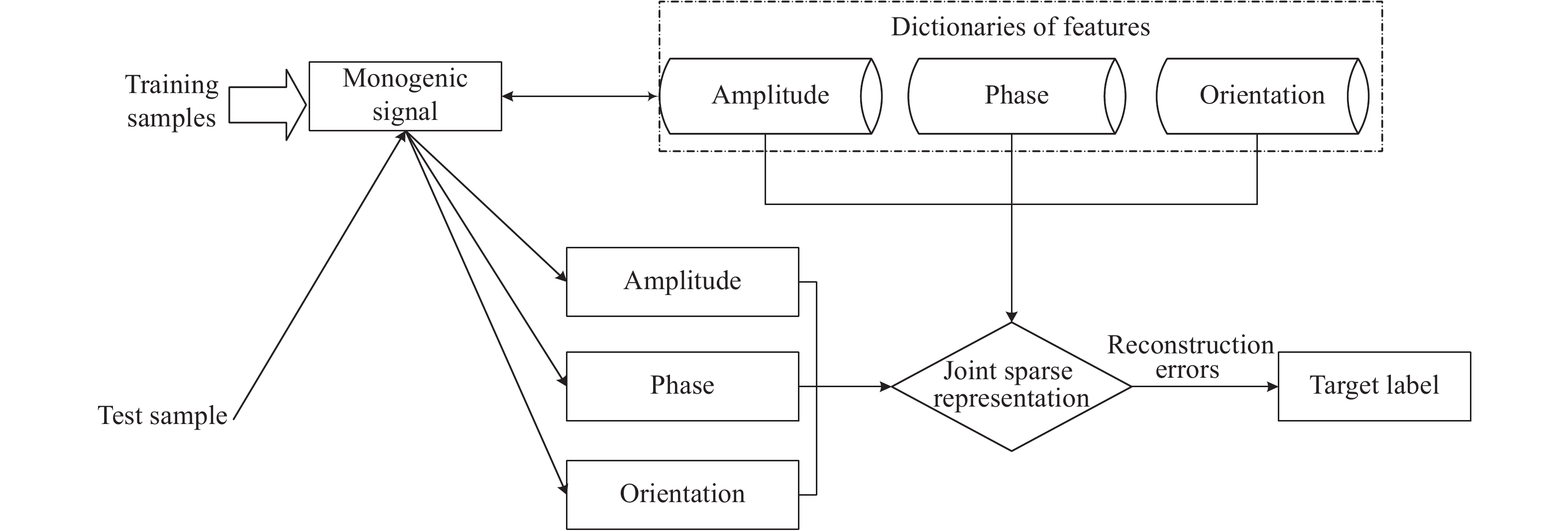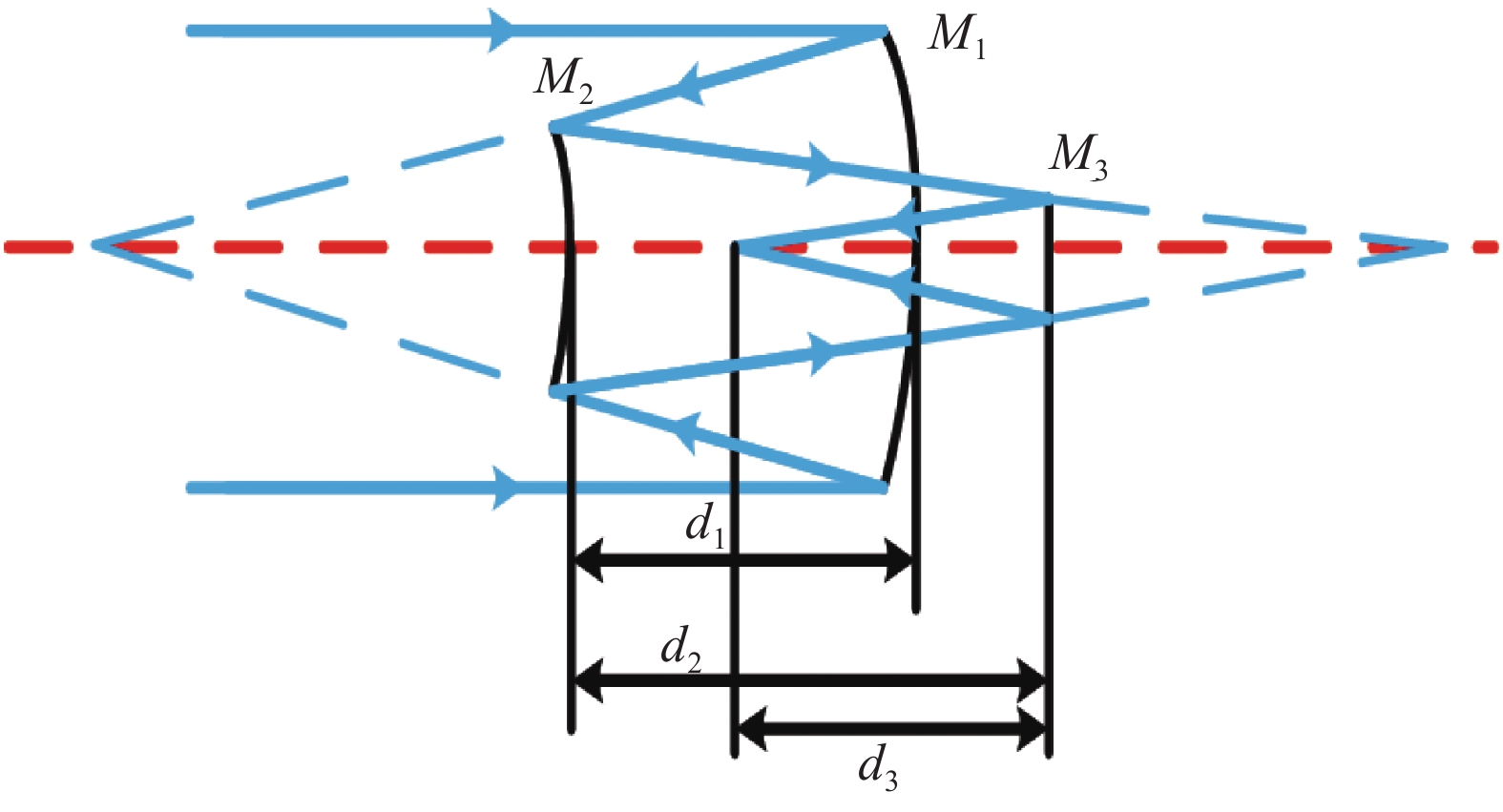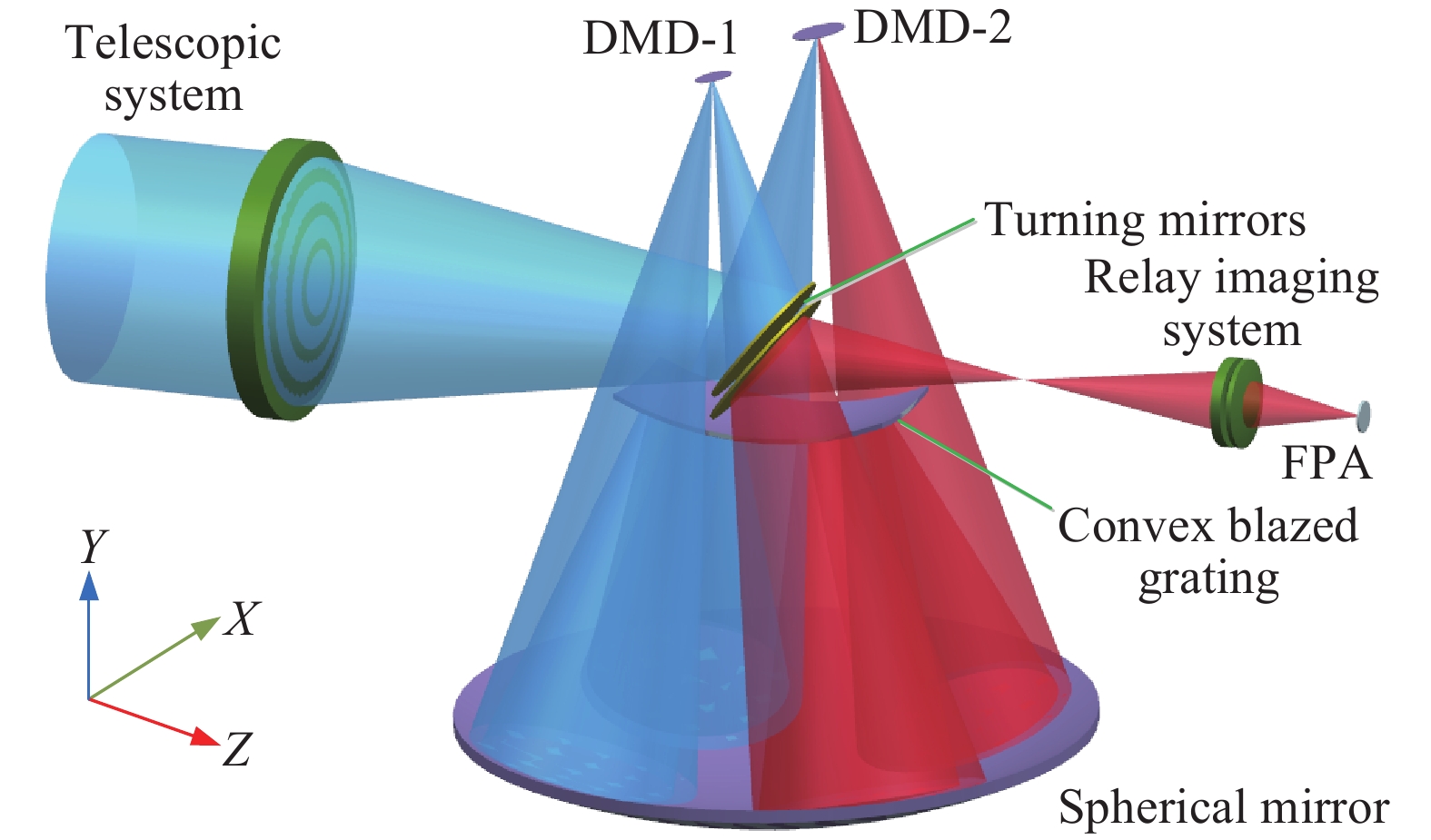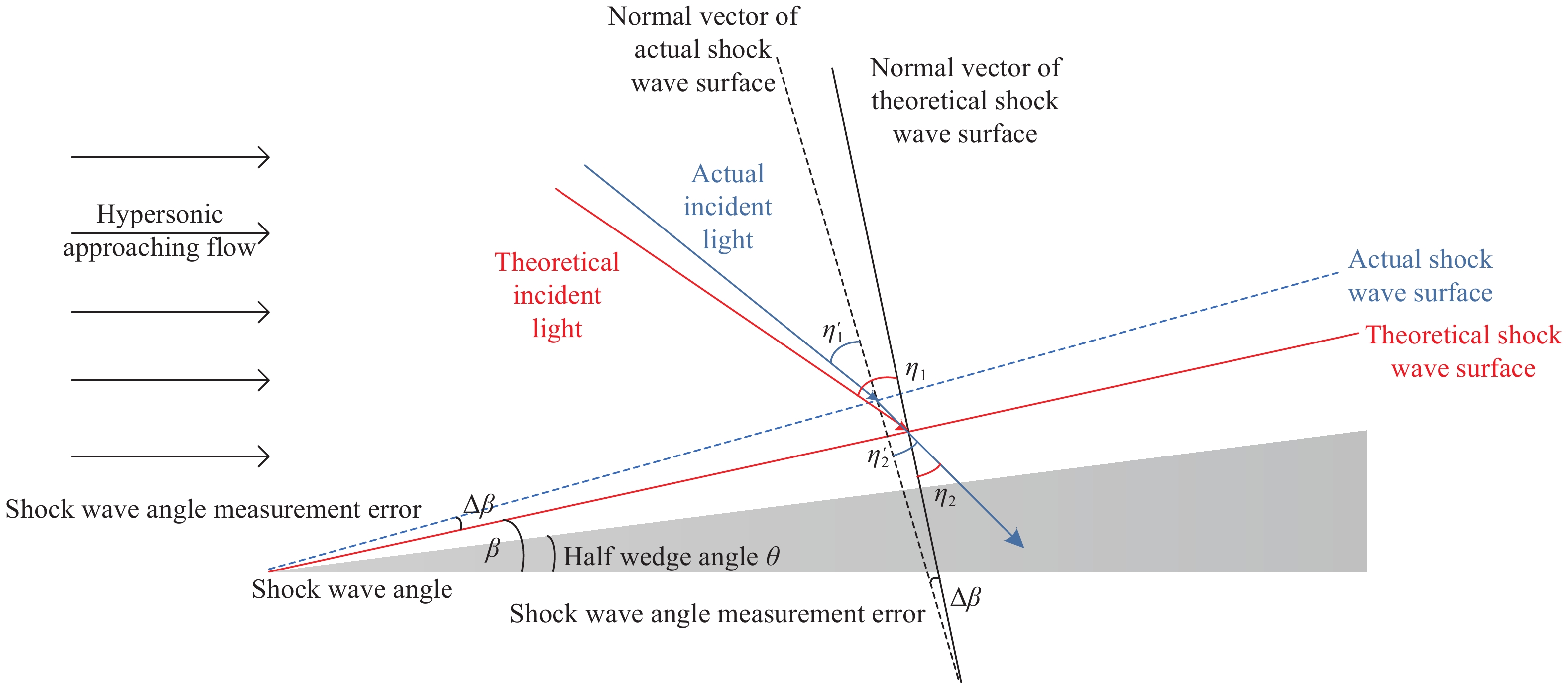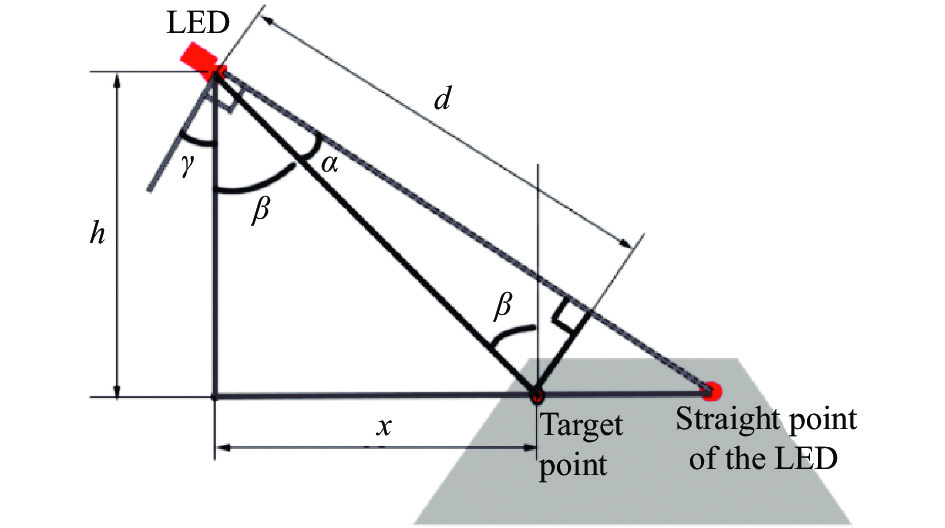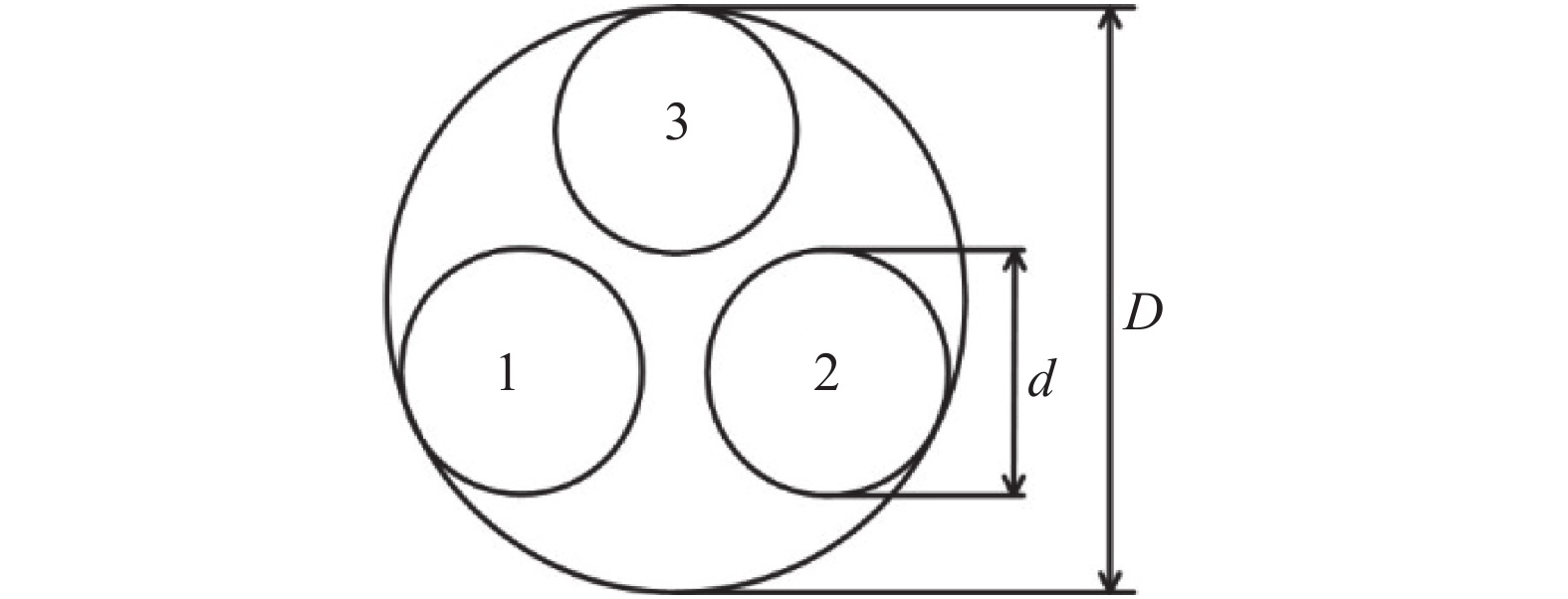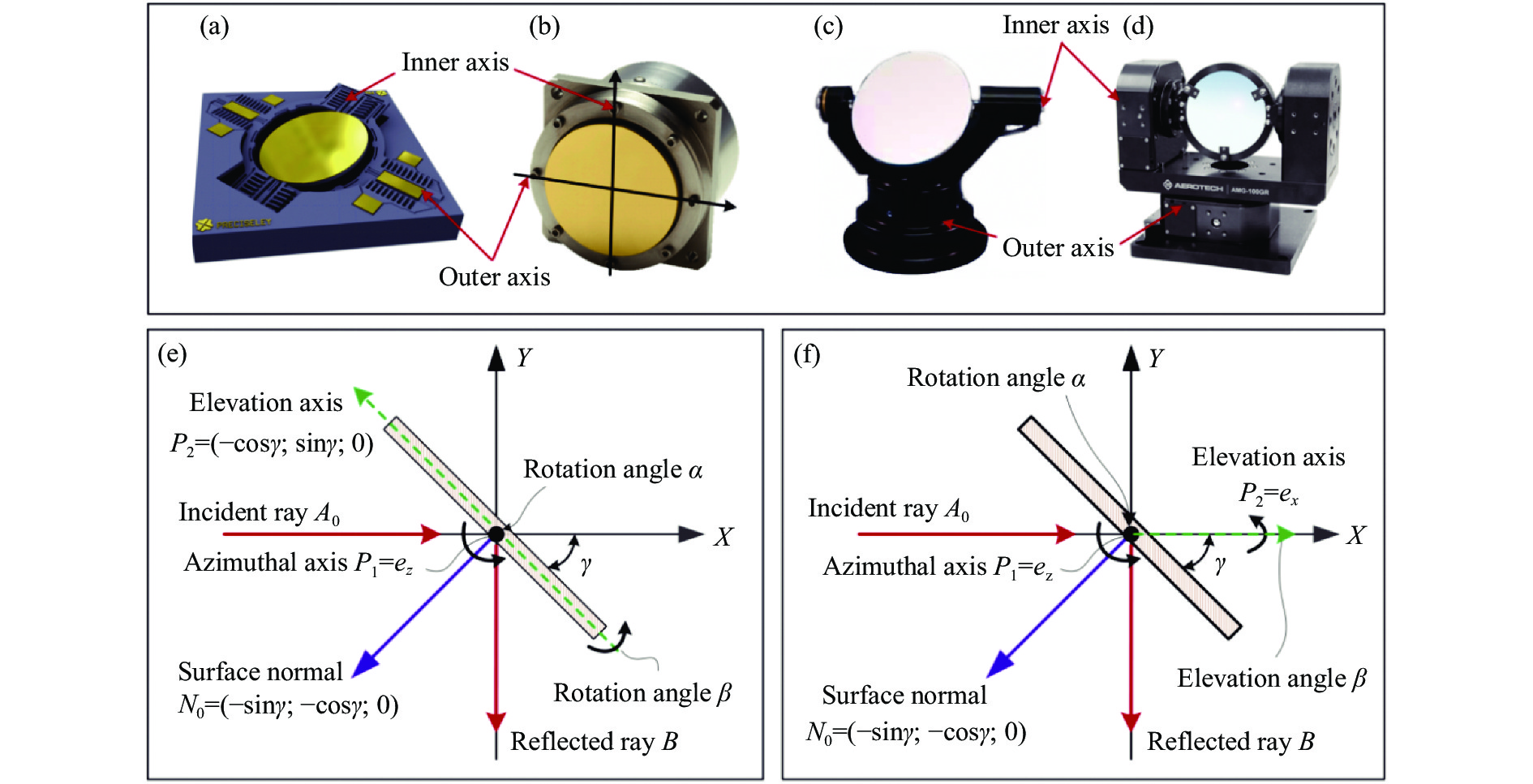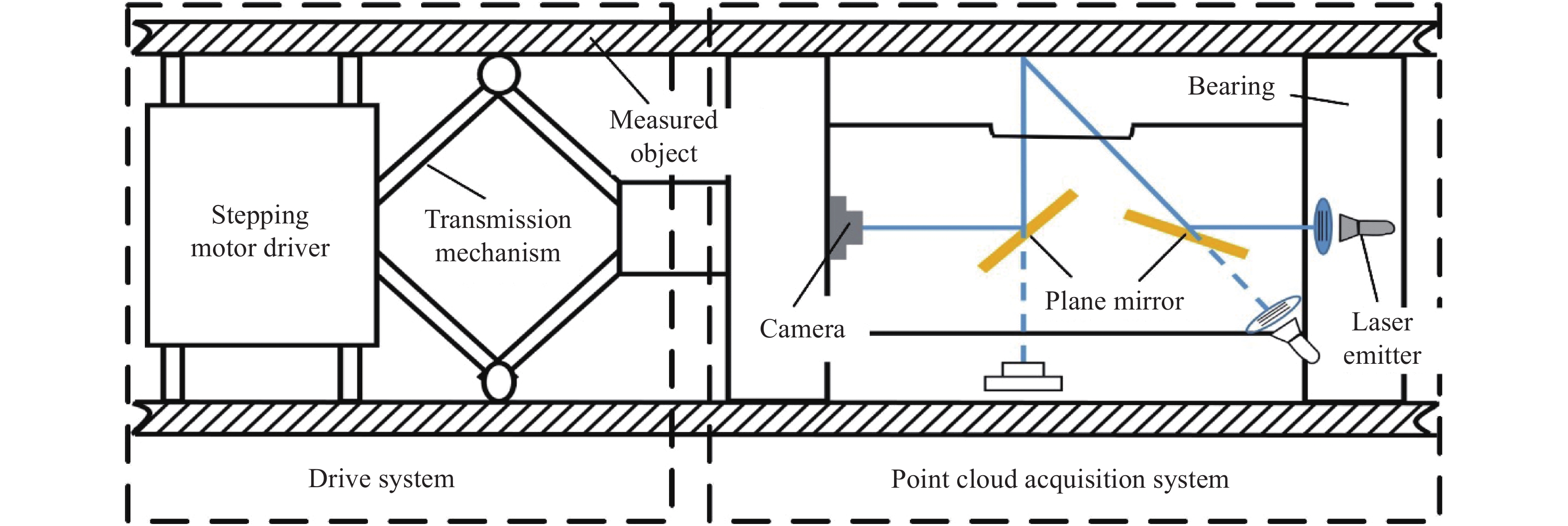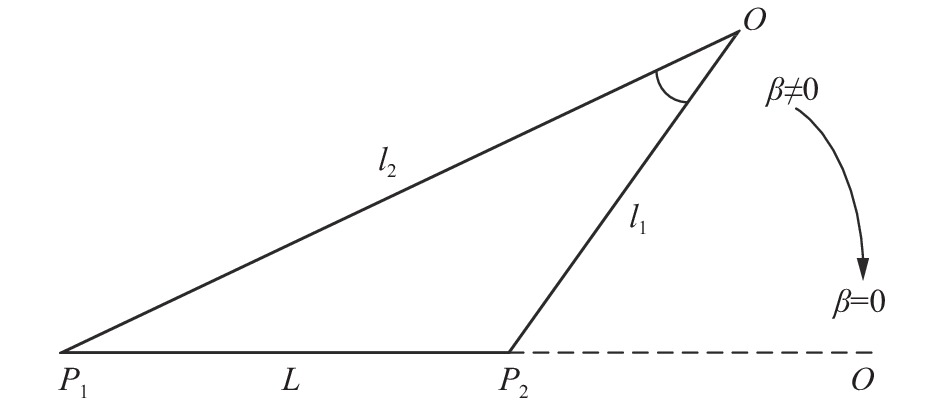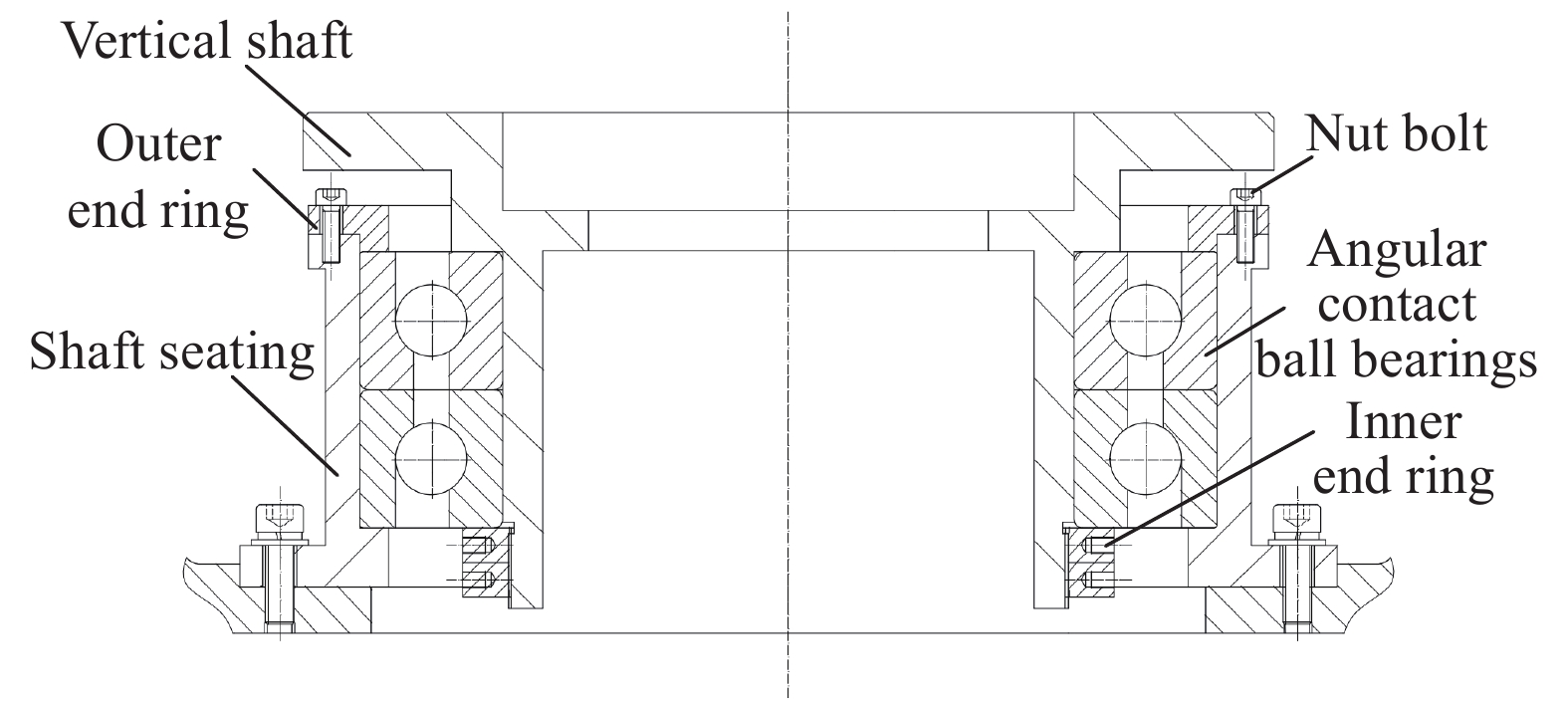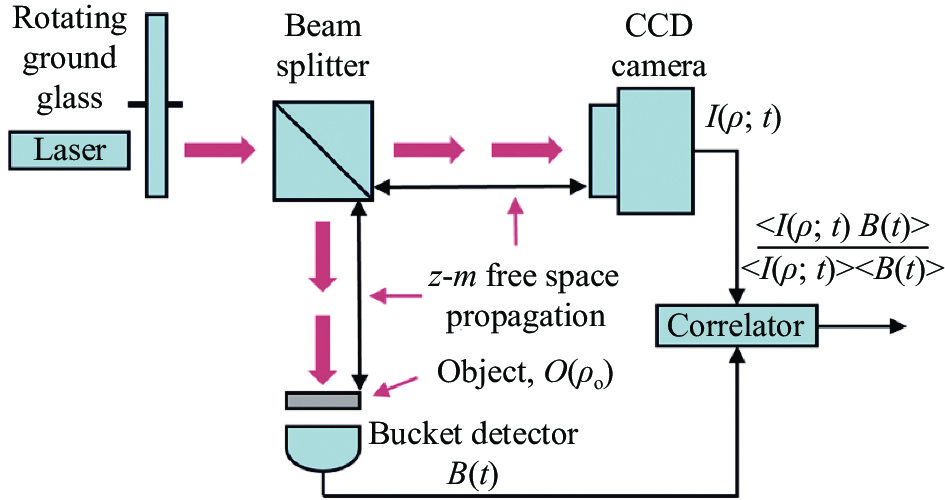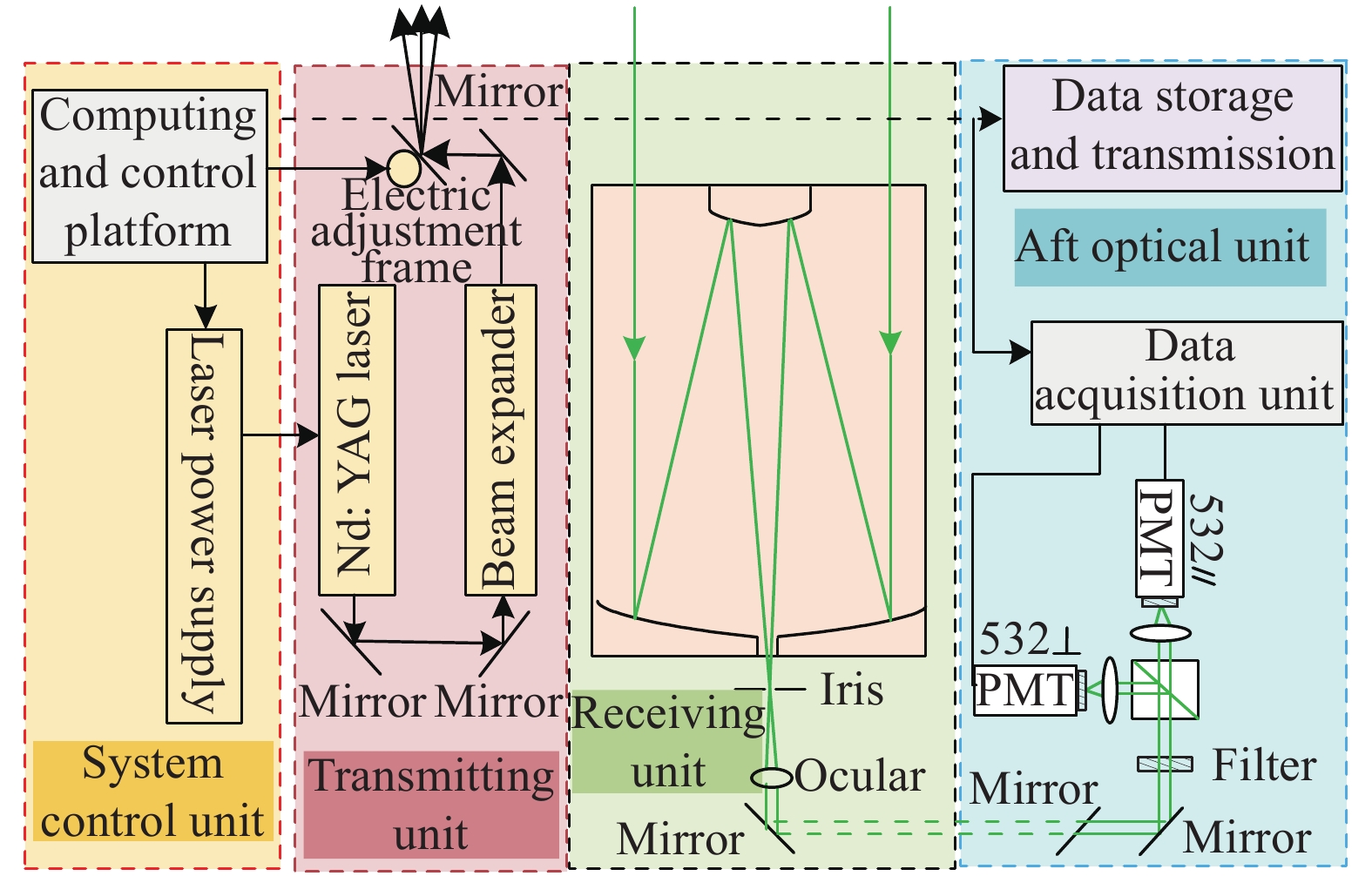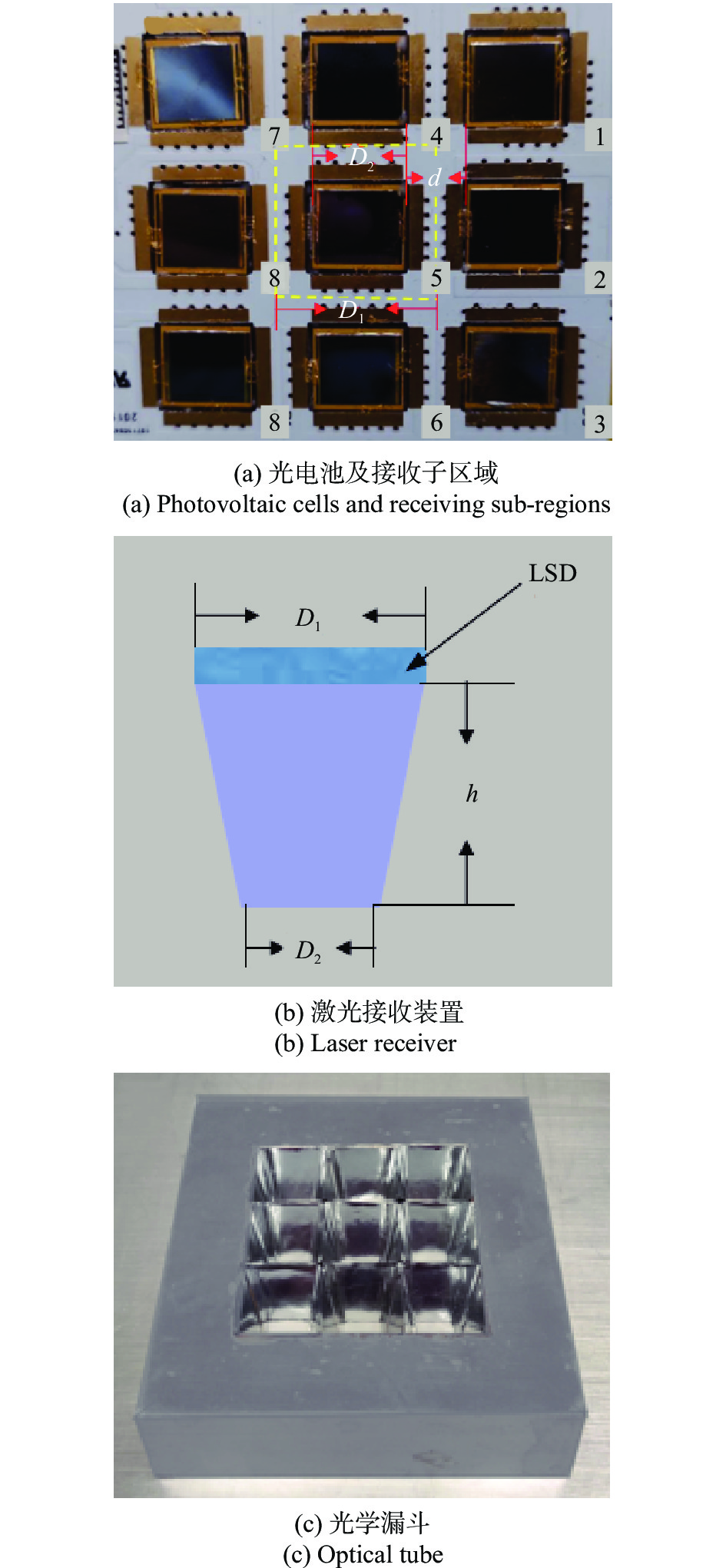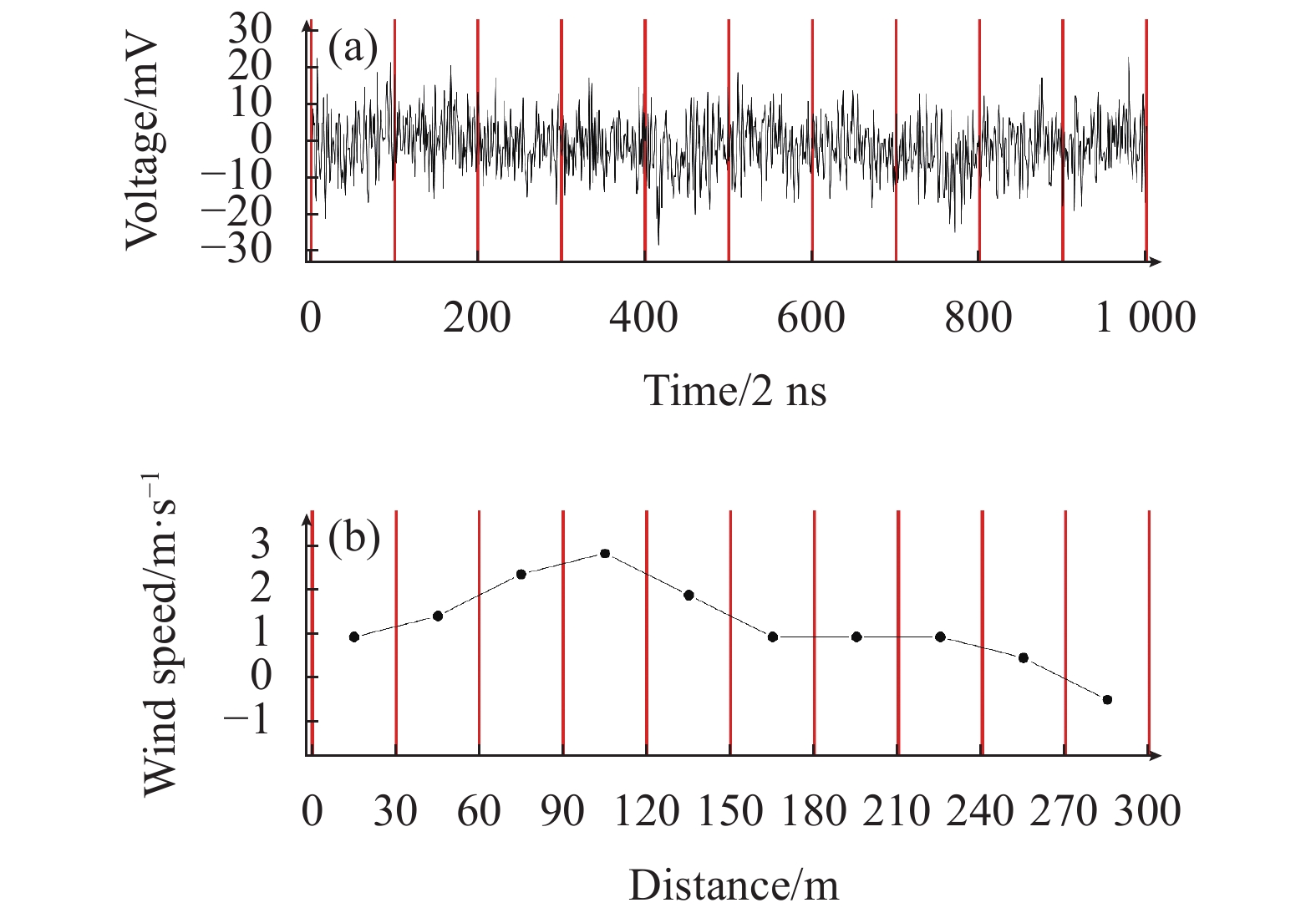2021 Vol. 50, No. 12
2021, 50(12): 20210080.
doi: 10.3788/IRLA20210080
In view of the current situation that the existing research of retrieval of secchi disk depth (SDD) was mostly based on lower resolution satellite data, the retrieval of secchi disk depth had been carried out using Sentinel-2 MSI image with a resolution of up to 10 m in Jiaozhou Bay. A retrieval model based on measured data was constructed. The results show that the retrieval model has high accuracy. The average relative error between the inversion value and the measured value is 9.86%, and the root mean square error is 0.22 m. Based on the constructed retrieval model and Sentinel-2 MSI image, the SDD in Jiaozhou Bay was inverted, the SDD distribution map was drawn, and the spatial distribution and local subtle change characteristics of the SDD in Jiaozhou Bay were analyzed. The study found that the SDD of Jiaozhou Bay showed a trend of gradually increasing from the coast to the sea. Rivers with large runoff caused changes that significantly reduce the SDD near the mouth of the river. The tide caused the texture change characteristics of SDD to appear along the direction perpendicular to the shore. The navigation of large vessels caused a short-term decrease of SDD.
2021, 50(12): 20210127.
doi: 10.3788/IRLA20210127
High resolution remote sensing imaging simulation technology for sea surface target has been widely used in sea surface target detection and recognition. The interaction between ship and seawater can be seen in high resolution, and the radiation simulation of complex flow field is the main difficulty of imaging simulation. The geometry and physical properties of the flow field generated by the interaction between the ship and the sea during navigation were studied, and the coupling model with the radiation characteristics of the sea surface was proposed. The three-dimensional model of sea surface was constructed by the method of spectrum analysis, and the three-dimensional model of ship navigation flow field was constructed by the method of computational fluid dynamics. According to the different distribution of sea surface components, the radiation characteristics were associated with the three-dimensional structure, and the three-dimensional radiation model of sub meter ocean scene was constructed. Through radiative transfer calculation, multiple reflection simulation in the scene, atmospheric influence and sensor effect simulation, the satellite remote sensing image under the observation condition was finally obtained. The results show that the mean error and standard deviation error of GF-6 satellite images are 9.17% and 9.21% respectively, which are compared with the simulated images under the same imaging conditions. The average gray value, gray distribution and texture details of the images are consistent, which can simulate the ocean target scene under high resolution satellite imaging.
2021, 50(12): 20210166.
doi: 10.3788/IRLA20210166
Aiming at the difficulty of a single method to balance the global and local information to accurately extract the edges of non-cooperative targets in the field environment, combined clustering and other algorithms a new method of edge extraction was proposed. Firstly, according to the image pixel value clustering, each two categories were divided by threshold to obtain a binary image and the binary images were subjected to or operation. Then, after the image was inverted, the connected domain with the largest area was retained to obtain the target segmentation image, and the target edge was extracted. Finally, sub-pixel edge calculation based on Zernike moment was processed. The new edge extraction method had strong adaptability, and could quickly and effectively extract the target edge in the actual environment. The non-cooperative targets in the experiment were the three inner holes of the device. The sub-pixel edges were extracted by the above method, and then the center of the circle was fitted, and the center was used for relative pose measurement. The experimental results show that the method is robust and accurate. The maximum position deviation is 0.12 mm, the measurement precision of the attitude angle which is perpendicular to the optical can reach 0.02°, and the measurement precision of the other two attitude angles can reach 0.07° and 0.08°.
2021, 50(12): 20210281.
doi: 10.3788/IRLA20210281
In order to solve the problems that lacking of infrared images for ship target and the difficulty of acquiring them, an improved infrared image data augmentation method with geometric space and feature space association for ship target is proposed based on the image geometry changes and feature fitting method with generative adversarial network. Firstly, the IR image of ship target was augmented by image transformation methods such as geometric transformation on geometric space, image hybridization and random erasure; Secondly, the pyramidal generative adversarial network (SinGAN) structure was improved according to the characteristics of the IR ship image, and the In-SE-Net inter-channel attention mechanism module was introduced in the generator to enhance the small sensory field feature representation, making it more suitable for the IR ship target; Finally, at the data set level, geometric data transformation based on geometric space and generative adversarial network based on feature space were combined to complete the data augmentation of the original dataset. Object detection algorithms such as YOLOv3, SSD, R-FCN and Faster R-CNN were used as benchmark models to carry out in infrared ship image data augmentation experiments. The average accuracy (mAP) of object detection were all improved by about 10% trained on the augmented data, which verified the feasibility of the proposed method on small-sample infrared ship image data augmentation. It also provides a data basis for improving object detection algorithm carried of infrared ship.
2021, 50(12): 20210165.
doi: 10.3788/IRLA20210165
Infrared imaging is an important measure for night observation, which is widely used in both military and civil fields. For infrared imagery target classification problem, the monogenic signal was introduced for feature extraction, which was used to analyze the target characteristics. The infrared image after single signal processing can be described by the amplitude, phase and orientation components. For each component, its multi-scale decompositions were processed by connection and downsampling to achieve one single feature vector. Finally, three feature vectors were generated to describe the multi-layer properties of the target. The joint sparse representation was employed as the representation model for the three feature vectors, which used their correlation to improve the overall reconstruction precision. The reconstruction errors of different classes were calculated based on the results from joint sparse representation and the target label could be further decided. The experiments were conducted on the medium wave infrared (MWIR) image dataset to classify the original, noisy, and occluded samples. By comparison with several existed algorithms, the validity and robustness of the proposed method for infrared imagery target classification could be confirmed.
2021, 50(12): 20210112.
doi: 10.3788/IRLA20210112
The interpretation of single remotely sensed data source may suffer from inaccurate boundary and low classification accuracy. The integration of hyperspectral and LiDAR data opens up the possibility to improve the classification performance. But, it is a challenge that how to appropriately integrate the considerable heterogeneity between the two types of data. In this paper, a conditional random field classification method was proposed to solve this problem by jointly taking both the heterogeneity of fused spectral-spatial-height features and co-occurrence of class labels into account. Firstly, the morphological features were extracted from two types of data respectively, and a graph model and training samples were jointly used to fuse the morphological features and spectral features. The obtained features were inputted into a support vector machine classifier to obtain the initial classification results with probabilistic outputs. Then, based on the fusion features, a local heterogeneity value was calculated to measure the essential difference of classes among pixels. Meanwhile, a class co-occurrence matrix, whose element calculated the spatial relationship between classes, was also obtained. Finally, a conditional random field framework was used to integrate the initial classification results, local heterogeneity information and the class co-occurrence matrix, and obtain the final classification results through inferencing two objective functions. In this process, by defining the weight between two neighboring pixel as a monotone decreasing function respect to the normalized Euclidean distance of the corresponding fused features, the object boundary could be regularized by giving a smaller weight to the class pairs with different labels and distinct features. Similarly, by giving a small weight to the class pairs with a strong spatial relationship, the purpose of maintaining the class pairs with stable spatial relations could be achieved. The method was validated with Houston and Gaofeng forest farm data sets. The overall accuracies of the proposed method reached to 94.00% and 92.84% respectively, and the "pepper and salt" phenomena of the initial classification results were significantly reduced. The result indicates the effectiveness of the proposed method.
2021, 50(12): 20210115.
doi: 10.3788/IRLA20210115
To address the problems of low matching accuracy, high computational cost and slow convergence speed of point cloud registration methods in Euclidean space, a point cloud registration algorithm based on geometric algebra was proposed by using geometric algebra’s expressive power for high dimensional space. Firstly, the point cloud data was transformed into geometric algebraic form, and based on the rotor of geometric algebra, the cost function of point cloud registration in geometric algebra space was given. Secondly, combined with the normalized least mean square algorithm, the solution of the rotor was simulated as a signal filtering problem, and the rotor iteration formula was constructed based on the steepest descent method in the geometric algebraic space, so that only one points pair instead of all point pairs was used for each calculation. The rotor obtained by iterative calculation could be used for any dimensional rotation estimation problem, so that the three-dimensional point cloud was gradually rotated and registered. Finally, in order to further optimize the conflict between the convergence speed and the steady-state error, a variable-step rotor iteration formula was given by using the Sigmoid function, which can speed up the convergence speed while reducing the steady-state error. The registration performance of the proposed algorithm was verified by using the model data set and the public data set. Compared with the classical iterative closest point algorithm, the registration accuracy of the model data set is increased from 10−2 to 10−8 orders of magnitude, and the registration accuracy of the public data set is increased by 35%. The proposed algorithm has faster convergence speed, higher registration accuracy and lower steady-state error.
2021, 50(12): 20210233.
doi: 10.3788/IRLA20210233
For the synthetic aperture radar (SAR) target classification method, a multi-view was developed based on the principle of the maximum entropy. The mutual-correlation matrix between multi-view SAR images was established based on the classical image correlation. Afterwards, the nonlinear correlation information entropy (NCIE) of different view sets was calculated. NCIE is capable of analyzing the statical properties of multiple variables and entropy value reflects the inner correlation of different variables. The view set with the highest nonlinear correlation information entropy was chosen, in which the multiple views share the highest correlation. The joint sparse representation was employed to represent the selected multi-view SAR images and the target label was determined based on the total reconstruction errors. The joint sparse representation is capable of handling several sparse representation problems and enhancing the reconstruction precision when these problems share some correlations. The proposed method could effectively analyze the inner correlations of multiple views and employ joint sparse representation to exploit such correlations so the classification accuracy can be improved. Typical experimental setups were designed based on the MSTAR dataset to test the performance of the proposed method while compared with some other methods under different test conditions. The results show the validity of the principle of the maximum entropy and the superior performance of the proposed method for SAR target classification.
2021, 50(12): 20210365.
doi: 10.3788/IRLA20210365
Aiming at solving the problem of fewer initial structures and complicated optimization processes for freeform surface off-axis reflective optical systems, a method for designing off-axis reflective optical systems based on quantum genetic algorithm was proposed. In such method, quantum genetic algorithm combined with aberration theory was adopted to obtain an initial optical system structure with good image quality, and then the off-axis process was accomplished and the freeform surface was further introduced to obtain the well-designed freeform surface off-axis reflective optical system. The method could easily and quickly provide initial structure with good image quality. Taking the off-axis three-mirror system working in visible light band as an example, a freeform surface off-axis three-mirror system with field-of-view of 10°×4° and F-number of 2 was designed with the primary mirror and the tertiary mirror being integrated together. Simulation results indicate that the designed off-axis three-mirror system exhibits a large field-of-view, a compact structure and a good image quality. The maximum root mean square (RMS) wavefront error of the system is 0.0485 λ (λ=0.6328 μm) and the modulation transfer functions (MTF) of the full fields are all greater than 0.9 at 50 lp/mm. Besides, the integrated structure is benefit for the simplification of the alignment and installation of the system.
2021, 50(12): 20210700.
doi: 10.3788/IRLA20210700
Dual-DMD based MWIR spectral imaging system encoding in spectral dimension was proposed, the tilt of image plane offset caused by the spectral encoding DMD was compansated by a DMD which in the spatial dimension. The composition and working principle of the system were introduced. As a front imaging unit, the telescopic system with a focal length of 240 mm and a F number of 3 was designed. The dual-pass Offner spectroscopic system and the spectral encoding DMD were used to realize multiple functions such as dispersion, encoding, and recombination. A relay imaging system with a magnification of 1 was designed to achieve strict matching of the cold stop. Through the integrated optimization design, the remaining aberrations of the dual-pass Offner spectroscopic system was compensated. The result of designing shows that the system has good spatial imaging and spectral performance, and the operating distance meets the design requirement.
2021, 50(12): 20210312.
doi: 10.3788/IRLA20210312
In order to meet the requirements of quick acquisition of aerial image information in low light condition, a wide view imaging system which can be adapted to low-light environments was studied. Based on the camera working mode of frame-sweep imaging, the technology route of adopting a large relative aperture and low distortion optical system, combining a low-noise and high-sensitivity CMOS detector with vacuum cooling, and compensating the scanning image motion by high-speed steering mirror was clarified. The design ideas of the mechanical configuration of the camera were explained in detail, and a set of calculation methods of imaging capabilities in low-light which can be applied in engineering were summarized. The basic principle of compensating image motion with steering mirror was studied, and the main frame of the camera was simulated, analyzed and calculated. According to the design and research results, the processing and assembly of the wide view aerial camera in low-light were completed. The camera has a ground sample distance (GSD) of 0.1 meters (height 1 km), and adaptable illumination range of 10-100000 lx, and a large view width of 3 times the height when the speed to height ratio is less than 0.04. The imaging quality of the system is excellent, and test results show that the MTF of the center field of view at 77 lp/mm is greater than 0.45. The images obtained from laboratory and field flight tests are clear, with high contrast and resolution, which can meet the requirements of use. At the same time, the system is 190 mm×140 mm×140 mm in actual size and 2800 g in weight, which is light and small.
2021, 50(12): 20210344.
doi: 10.3788/IRLA20210344
In order to improve the dynamic characteristics of the secondary mirror support structure of a large aperture space telescope and obtain better imaging quality, a method of damping vibration by coating a hard damping coating on the thin-walled beam of the secondary mirror support was proposed based on the comparison of the advantages and disadvantages of the current methods. Firstly, the optimal coating thickness and elastic modulus of the hard coating were analyzed with the objective of optimizing the comprehensive performance of the hard coating and secondary mirror support composite structure. Then, the acceleration response curve of the secondary mirror support structure before and after the hard coating was analyzed with ANSYS. Finally, the effects of the hard coating on the optical imaging performance were analyzed by using Zemax and Matlab software respectively from the rigid body displacement and the mirror surface profile change. The analysis results show that the acceleration response of the secondary mirror assembly in X, Y and Z directions decreases by 30% to 50% compared with that before coating under a sinusoidal excitation of 6 g magnitude, and the imaging quality and the precision of the secondary mirror model of the optical system are also greatly improved.
2021, 50(12): 20210209.
doi: 10.3788/IRLA20210209
In practical terms of model identification for optical infrared telescope servo system, the measured states often contain noise. In order to improve accuracy of modeling, a sparse identification method based on Spark Identification of Nonlinear Dynamics with Control (SINDYc) algorithm was proposed. For the telescope servo system, theoretical analysis and numerical simulation of the SINDYc algorithm were carried out. The state variable curves of the telescope servo system model under different noise levels were compared, and the determination coefficient curve of the identification model under different noise levels was fitted. Based on the antarctic telescope experimental platform, sine and square wave signals were designed as excitation signals for model identification experiments, and the modeling accuracy of the SINDYc algorithm was experimentally verified. The prediction results of the numerical simulation model show that the identification accuracy of SINDYc algorithm is above 0.99 when the noise level is below 20%. When the noise level is below 10%, the maximum deviation is within 5% of the signal amplitude. The identification experimental data show that the accuracy of model prediction is 0.9857 and 0.9952 under the excitation of two different signals. The effectiveness and accuracy of the sparse identification method based on the SINDYc algorithm are confirmed by numerical simulation and experimental validation. The obtained model by this identification method can provide a good analytical model for the analysis and controller design of future large-aperture optical infrared telescope control systems.
2021, 50(12): 20210182.
doi: 10.3788/IRLA20210182
Celestial attitude determination is one of the important technical means for high precision autonomous navigation of aircraft. Shock waves are generated along the surfaces of hypersonic vehicles, which cause beam deflection, affect the observation of star trackers and celestial navigation performances of these vehicles. Most modern hypersonic vehicles adopt the wave-rider design, and the payload bay can be simplified into a wedge plane structure. The shock waves over hypersonic vehicles with wedge-shaped upper surfaces were analyzed. Based on aero-optical theories an analytical calculation method of the structure parameters of the wedge shock wave and a quantitative calculation model of the impact of the shock wave on the deflection of light were given. A correction model was proposed to control the deflection of beam by using the analytical calculation results. The propagation of shock angle measurement error in this model was discussed, and it was proved that the shock angle measurement error was negatively linear correlated with the correction effect deviation caused by it. The simulation results show that under the condition of altitude 20 km and Mach number 5-8, a stable shock wave structure is formed above the wedge surface, and the deflection of incident beam can be up to 6.8 arcseconds. The error between the shock angle parameters obtained by the analytical calculation method and the test results is within 0.1 arcseconds. This means that the error of beam deflection correction by using this model can be controlled at the order of the shock angle measurement error, and the observation accuracy can be significantly improved.
2021, 50(12): 20210745.
doi: 10.3788/IRLA20210745
To address the issues that the illumination effect evaluation elements were limited and the illumination optimization methods were lack of universality in current research of illumination optimization method of LED light source for visual inspection system, an illumination optimization method of LED light source for visual inspection system based on improved Salp swarm algorithm, taking visual inspection on chip package quality as example in this paper. A mathematical illumination model of single LED light source was established, based on which the mathematical illumination model of standard strip shape LED array was proposed to obtain the illumination values of the LED array in arbitrary spatial position and measured plane. The plane illumination effect evaluation function was constructed in comprehensive consideration of the illumination uniformity, the average illumination, the illumination gradient variation, the threshold reaching standard, the distinguishability of target and background area. An improved salp swarm algorithm (ISSA) was proposed to optimize the computing procedure of plane illumination effect evaluation function and obtain the spatial position parameters of optimal illumination effect. The update strategies of the convergence coefficients, the Salp speed, the leader and its followers’ position were improved, to enhance the diversity of area searching in ISSA. The experimental results show that based on the observation of the relative illumination distribution of the optimize area, the illumination distribution obtained by the propose method is basically consistent with the illumination distribution by actual measurement, the illumination uniformity of the target area is above 98.78%, and the maximum difference is within 5.57%. Therefore, the proposed method had a reasonable optimization objective and could be used to obtain the spatial position parameters of optimal illumination effect for visual inspection system.
2021, 50(12): 20210058.
doi: 10.3788/IRLA20210058
To resolve mutual restriction of viewing angle and luminance, a high luminance integral imaging display based on a gradient line light source was proposed. The light paths of the elemental images in the element image array were optimized by adjusting the widthes of the line light sources in the gradient line light source. The imaging model of the integral imaging display based on the gradient line light source was established. The calculation formulas of the viewing angle and luminance were obtained by using geometrical optics. An experimental apparatus of the integral imaging display based on the gradient line light source was built. The experimental results prove that the luminance of the 3D image is 4.5 times of the conventional one without loss of the viewing angle.
2021, 50(12): 20210189.
doi: 10.3788/IRLA20210189
In order to study the influence of atmospheric turbulence on the imaging quality of multi-aperture optical system, a theoretical analysis model was established for the Golay3 structure. The expression of point spread function (PSF) and modulation transfer function (MTF) of this structure were derived. To discuss the influence of similar circular and elongated turbulence structures on the imaging characteristics, the MTF under two turbulence conditions were calculated and compared, and the phase calculation models were constructed. The results show that when there is presence of turbulence in the optical path, the image quality of the system will decrease. As for similar circular turbulence, the smaller the intensity of turbulence is, the less the impact on the MTF is. Specially, the MTF affected by turbulence of different intensities decreases by about 0.05 at the normalized spatial frequencies of 0.16, 0.45, and 0.69. As for similar elongated turbulence, the smaller turbulent wind speed is, the less the impact on the MTF is. The MTF affected by turbulence of different wind speeds decreases by about 0.25, 0.09, and 0.05 at the spatial frequencies of 0.16, 0.42, and 0.69, respectively. The comparison of the influence of the two turbulences on the system shows that the similar elongated turbulence has a more obvious influence on the MTF.
2021, 50(12): 20210131.
doi: 10.3788/IRLA20210131
Due to seawater absorption, scattering attenuation and ocean turbulence effects, the optical signal at the receiving end of the underwater wireless optical communication (UWOC) system will flicker. The flickering signal will result in a decrease in the transmission performance of the UWOC system. Based on the Gamma-gamma distribution of the ocean turbulence channel model, according to the equivalent structural parameters represented by ocean turbulence parameters and anisotropy factors, the closed expressions of the outage probability (OP) and the average bit error rate (BER) of the wavelength diversity UWOC system were derived. With the increase of the anisotropy factor, the changes in the outage probability and the average bit error rate of UWOC system with different wavelength diversity orders were analyzed. The average bit error rate difference of the UWOC system between the optimal combining (OC) and the equal gain combining (EGC) used at the receiving end technology were compared, and the influence of different ocean turbulence parameters and transmission distances on the performance of the wavelength diversity UWOC system was simulated. The numerical results show that the ocean turbulence effect on the UWOC system gradually weakens with the increase of the anisotropy factor. The UWOC system with wavelength diversity technology has significantly improved the outage probability and the average bit error rate than the UWOC system without wavelength diversity technology.
2021, 50(12): 20210146.
doi: 10.3788/IRLA20210146
To realize the coarse tracking of laser communication terminal (LCT) with a single plane mirror (Tip-Tilt mirror type)and two orthogonal rotation axes, a normal vector solving algorithm for beam pointing was proposed. The coarse tracking algorithm of this type LCT was given. By using vector reflection law and matrix rotation transformation, a theoretical derivation of the tip-tilt mirror was carried out to get the analytical solution of the beam pointing model and tracking model. The effects of different installation methods on the beam pointing and distortion were discussed. The model was researched on modeling simulation and experiment respectively. The results show that the accuracy of the beam pointing model and the coarse tracking model are better than 3 µrad. The developed LCT has a coarse tracking accuracy better than 15.5 µrad (3σ), and the RMS error is better than 10.5 µrad. It meets the high-precision coarse tracking requirements of the LCT. The work has reference significance for beam pointing analysis of the Tip-Tilt mirror type scanning system and laser terminal coarse tracking.
2021, 50(12): 20210195.
doi: 10.3788/IRLA20210195
In the monitoring process of human motion and posture, knee movement information was of great significance in the diagnosis and rehabilitation evaluation of chronic diseases in the middle and old age. The knee directional bending measurement device using a Mach-Zehnder interferometer-based directional bending (MZI-BDB) sensor was presented in this paper. The system consisted of MZI-BDB sensor, swept laser light source, optical fiber coupler, optical fiber isolator, photodetector and signal processing system. MZI-BDB sensor was fabricated by fusion-splicing a section of eccentric core fiber (ECF) between two single-mode fibers (SMF) with core-offset. It was encapsulated in a soft silicone sheet and fixed to the knee joint by a band. When the knee joint was flexed and extended, the MZI-BDB sensor was led to bend, causing the modal interferes of the sensor changes and the resonant wavelength shifted, so as to monitor the bending direction and curvature of the knee joint. The range of measurement of MZI-BDB sensor was 0°-90° at the positive and negative bendings respectively. At the positive bending (bending direction of 0°), the proposed MZI-BDB sensor sensitivity and resolution were 5.29 nm/m−1 and 0.11 m−1 respectively. The sensitivity and resolution were −3.11 nm/m−1 and 0.12 m−1 at the negative bending (bending direction of 180°). The temperature sensitivity of the proposed MZI-BDB was 0.043 nm/℃, which had minimal effect on the experiments. Furthermore, the photoelectric encoder and MZI-BDB sensor were used for data acquisition simultaneously. The experimental results show that the detection system and the photoelectric encoder verification platform are consistent in accuracy and responsiveness.
2021, 50(12): 20210055.
doi: 10.3788/IRLA20210055
The filter element with high transmittance, narrow spectral bandwidth and high suppression ratio is the core component to improve the spectral purity of an optical system, and it is also a hot research direction in the field of new optical devices in recent years. The traditional filter elements can not meet the requirements of transmittance, spectral bandwidth and out-of-band suppression simultaneously. As a new type of grating, the diffraction efficiency of the volume grating is usually greater than 90 %, the spectral bandwidth is about 100 pm, and it has angle filtering characteristics. Based on the coupled-wave theory, the influence of grating parameters (grating thickness, refractive index modulation, grating period, grating inclination angle) on the diffraction efficiency and spectral bandwidth of the grating was theoretically simulated, and the influence of parameters was quantitatively given, which provided theoretical guidance for the design of volume grating. The volume grating test system was designed, and the diffraction efficiency, spectral bandwidth and angle selectivity of the volume grating were verified by experiments. The experimental results are in agreement with the theory. The diffraction efficiency is greater than 90% , and the spectral bandwidth is about 100 pm, which provides support for the practical application of the volume grating.
2021, 50(12): 20210402.
doi: 10.3788/IRLA20210402
In order to meet the demand for high signal-to-noise ratio and low-noise optical streak camera in inertial confinement fusion (ICF) physical experiment diagnosis, a cathode-gated optical streak camera with six electrodes streak image tube was developed. To suppress the camera noise, a method that loading DC high voltage while superimposing gated high voltage pulse to the photocathode was used. In this way, the streak image tube of the camera was in the normal working state only during the gated pulse loading time, and the electrons emitted by the cathode could be normally focused and scanned. When the control pulse was not loaded, the voltage at the second focusing electrode could be lower than the cathode voltage, so that the photoelectrons emitted by the cathode would be reversely cut off. Therefore, the camera only measured the useful signals that arriving within the gated pulse loading time, thereby effectively suppressing the background noise introduced by the optical streak camera irradiated by ambient light, and improving the camera's signal-to-noise ratio. The verification experiment shows that by loading the gated pulse voltage with amplitude of − 5.5 kV and pulse width of 203 ns on the cathode, the camera noise can be greatly reduced, and the spatial resolution of the camera can be maintained.
2021, 50(12): 20210130.
doi: 10.3788/IRLA20210130
In order to improve the calibration accuracy of camera parameters, the improved Zernike moment and eccentricity error correction were used to locate the center of the circle with high accuracy for the problem of blurred edges and eccentricity of spatial circular projection when calibrating with circular feature points in stereo vision system. The problem of blurred edges of circular feature projection image caused by uneven illumination intensity at the calibration site of stereo vision imaging system was firstly considered, and the Gaussian error function was introduced to describe the grayscale distribution of the edge transition section. The Gaussian edge model was established, and Zernike moments of the projection image were calculated based on this model, and then the improved Zernike moments were used to achieve high-precision circular feature projection edge pixel coordinate positioning. In addition, the factors that affecting the deviation between the projection point of the circular feature and the fitted circle center were analyzed, and the deviation compensation of the iterative fitted circle center was made based on this analysis to make it close to the real circle center projection, and lastly the circle centers of 99 circular marker points were extracted and used for the calibration of the camera parameters by the proposed algorithm. The simulation experiments show that the accuracy of the algorithm for edge positioning of the projected image and the accuracy of the circle center fitting are higher than those of the traditional algorithm; In the practical measurement experiments, it turns out that the length measurement accuracy of standard rod based on the proposed method is improved by 30% compared with traditional methods.
2021, 50(12): 20210711.
doi: 10.3788/IRLA20210711
To reveal mechanism of influence of environmental factors such as ambient temperature, sunshine and wind velocity on infrared thermographic nondestructive testing, modeling of a delamination in a glass fiber reinforced plastic specimen in infrared flash thermography testing was made and studied. The model was an axial symmetry model. Thermal signals to be detected in infrared thermographic nondestructive testing, such as temperature difference, the maximum temperature difference, temperature contrast and the maximum temperature contrast, were calculated and analyzed using finite element method in that model. Several experiments with special process treatment on that specimen were carried out. Evolution of the thermal signals with changes of those environmental factors was researched. Comparison of results from modeling and experiment in ambient temperature 25 ℃ and 30 ℃ was made. Results from modeling and experiments in uneven sunshine and in homogeneous temperature were compared too. Results in deferent wind speed were presented at the end of this paper. Convective heat transfer coefficients in the model were 10 W/(m2·K) and 100 W/(m2·K). The simulation results and the experiment results show that the maximum temperature contrast declines with increase of ambient temperature. Decline of the maximum temperature contrast means that clarity of defect gets worse, and detection of defect becomes more difficult. The maximum temperature difference and the maximum temperature contrast increase or decrease due to uneven sunshine on the specimen. Those changes lead to misjudgment or missing detection. Increase of wind velocity may reduce the maximum temperature difference and the maximum temperature contrast, and result in worse detectability and clarity of defect.
2021, 50(12): 20210210.
doi: 10.3788/IRLA20210210
The single-view point cloud obtained by the deep hole inner surface inspection system cannot reflect the full picture of the inner surface of the deep hole part. In order to realize the three-dimensional reconstruction of the complete surface shape of the deep hole inner surface, a pose calibration technology for the deep hole inner surface inspection system was proposed, which was used to provide the initial value of the point cloud stitching for the reconstruction of the inner surface of the deep hole. Firstly, the principle of deep hole inner surface detection technology was introduced, the coordinate transformation model of deep hole parts measurement point cloud was analyzed and established, the system pose parameters that need to be calibrated in the coordinate transformation model were determined; Then, the measurement trajectory of the system was described by the rotation axis angle, and the point cloud was reconstructed inversely; Then the measurement trajectory model was optimized with the solution error of the system parameter as the loss function, and the system pose parameter calibration was realized; Finally, point cloud splicing experiments of the straight cylinder and the concave groove show that the method was suitable for the detection of the inner surface of the deep hole and easy to operate, the splicing error was not more than 0.08 mm. Compared with other methods, it has certain advantages.
2021, 50(12): 20210196.
doi: 10.3788/IRLA20210196
The eccentricity of the optical axis of the large-aperture concave ellipsoid mirror will cause the misalignment of the optical system of the remote sensing camera, resulting in the deviation of the imaging focal plane from the designed position. To solve this problem, an aspheric system based on optical flat compensation was designed according to the geometrical parameters of the mirror. Through sensitivity analysis and calculation, it was found that the optical flat misalignment 1" had no effect on the system aberration. The primary mirror misalignment 1″ caused a coma of 0.04λ (λ=632.8 nm). Combined with the results of simulation calculation, the test optical path was built, and the eccentricity of the mirror was measured by theodolite and laser tracker. The error analysis shows that the tilt error of the primary mirror is about 1.2″, and the eccentricity measurement error of the primary mirror is 0.028 mm, which can meet the measurement requirements of the large-aperture mirrors of most space remote sensing cameras.
2021, 50(12): 20210624.
doi: 10.3788/IRLA20210624
In the traceability of length standards of different sizes, in order to solve the problems of lack of effective error analysis and low measurement efficiency of mirror reflection laser tracking interferometric length measurement, the length measurement error caused by the plane mirror adjustment resolution and flatness was studied. The allowable range of plane mirror angle adjustment for different lengths was obtained. The model of mirror reflection laser tracking interferometry was established, and the source of measurement uncertainty of the model was analyzed. The influence of plane mirror angle adjustment was simulated. The length measurement comparison experiment of coordinate measuring machine and the plane mirror angle adjustment experiment were carried out. The experiment shows that the En verification result of length measurement comparison is less than 1, which proves the accuracy of length measurement uncertainty. Through the plane mirror angle adjustment experiment for different lengths, the measurement results with measurement uncertainty of 3 $ {\text{μm}} $ (length 1 m) and 3.7 $ {\text{μm}} $ (length 2.5 m) were obtained. The measurement efficiency was improved by 56%. Experiments verify the accuracy and efficiency of this method. This method realizes the high-precision measurement of length and the analysis of measurement uncertainty.
2021, 50(12): 20210623.
doi: 10.3788/IRLA20210623
Interventional needle shape monitoring method can provide doctors with important information during surgery and is a necessary means to ensure the safety of surgery. In order to improve interventional needle shape measurement accuracy, a fiber grating sensor (FBG) array was presented, which introduced a strain sensitivity matrix to measure the shape of the probe. Firstly, based on the theory of FBG, the relationship between the wavelength shift of the fiber grating implanted in the probe and its strain was analyzed, and the strain sensitivity matrix was introduced, the relationship between the FBG center wavelength shift and its bending curvature was studied. Then the geometric parameter relations and coordinate transformation equations of the needle's local elements were deduced, and the needle shape reconstruction model based on fiber grating was established. Finally, in order to verify the influence of introducing the strain sensitivity matrix on the shape measurement accuracy, the shape measurement experiment of the intervention needle implanted with the FBGs array under different bending states was carried out, and the error of the shape measurement before and after the strain sensitivity matrix was compared and analyzed. The experimental results show that the introduction of the FBG’s strain sensitivity matrix can effectively improve the measurement accuracy of the needle. Under different bending conditions, the average error of the end of the interventional surgical needle is reduced by 1.385 mm, and the maximum error is reduced by 3.317 mm. The shape measurement method based on FBGs array proposed in this paper has broad application prospects in the direction of shape measurement of flexible medical instruments in interventional surgery.
2021, 50(12): 20210161.
doi: 10.3788/IRLA20210161
According to the axis offset, arosed by rotation of azimuth or pitching axis, was biggish than index in the test of certain remotion platform, the error sources were analyzed comprehensively. And then, a kind of error test and compensation plan was proposed based on this, multi-body kinematics theory was used to setup correction model of axis pointing deviation of the remotion platform. Subsequently, the test experiment of pointing deviation was designed to gain the actual pointing error, the unknown parameter of the correction model were obtained by measured data. Finally, model simulation and experimental test results after compentation both show that the horizontal axis offset error has been reduced from 176.1″ to 1″, the vertical axis pointing accuracy has been improved from 18″to 9″ after correction of error sources, and the error test and correction method has been successfully used in the actual test of the remotion platform, which satisfied the normal requirements.
Tilt error correction of minitype theodolite’s vertical shaft based on angular contact ball bearings
2021, 50(12): 20210172.
doi: 10.3788/IRLA20210172
The design of minitype theodolite’s vertical shaft which based on angular contact ball bearings usually refer to similar model for estimation and analogy. This method can effectively improve the design efficiency as well as endowing the vertical shaft a better engineering practicability. However, these experience-based designs hardly reach the best options, hence leaves room for optimizing and improvements. The vertical shaft of a small theodolite was studied from tilt error correction. The shaft optimization parameters were determined based on the physical model. Then the design parameters of bearing outer end ring were optimized by using finite element analysis. At the same time, the selection of bearing fit clearance’s design parameter values were analyzed through tilt error theoretical modeling. Meanwhile, the biaxial perpendicularity errors of this small theodolite with and without optimizing were both detected after partial load hoisting. The result shows that the biaxial perpendicularity error of optimized theodolite is lower with an approximate value of 6", compared unoptimized theodolite with an approximate value of 20". Tilt error of the rear vertical shaft is less than that before optimizing. The rationality and effectiveness of this optimization method mentioned are verified.
2021, 50(12): 20210158.
doi: 10.3788/IRLA20210158
To solve the problem of discrepancies between calculation results and test results of the polarization meridian Monte Carlo method, an improved algorithm which can limit receiving range was proposed. All forward scattered light was received generally in real receiving devices in the process of calculation, but part of forward scattered light was collected. This is one of the important factors causing discrepancies and mismatch between calculation results and test results of the polarization meridian Monte Carlo method. For this reason, an improved algorithm was proposed to limit receiving range of forward scattered light. Receiving range of the improved algorithm was consistent with real receiving range. Original algorithm and improved algorithm were used to simulate the propagation of 45°- and horizontally- linearly polarized light in polystyrene suspension, respectively. Then, the polystyrene suspension with particle size of 1 μm were selected to carry out verification experiments. Compared with the original algorithm, simulation results of the improved algorithm were closer to measured values. Finally, the polarization state distribution of a single particle was calculated to clarify mechanism of improved accuracy. Retention of polarization state(RoPS) changes drastically as forward scattered angle extends. Improved algorithm avoids most of forward scattered light with larger forward scattered angles.
2021, 50(12): 20210141.
doi: 10.3788/IRLA20210141
To reduce the time consumption of the three-axis vision measurement system in the focusing process and improve the accuracy of focusing, an auto-focus algorithm based on the optical defocus model was proposed. The evaluation function of the auto-focus algorithm adopted the Tenengrad gradient function. The search algorithm was divided into two steps: (1) The optical defocus model was decomposed into two curve functions, the two curve functions were solved through collecting the sharpness values of 4 images and their x-axis coordinates and the intersection position of the two curves was obtained. The intersection position was the approximate position of the on-focus position; (2) One image was collected at the intersection position and two images were collected on the left and right sides of the intersection point. The mean value of the fitting Gaussian function was obtained by Gaussian function fitting, which was the exact on-focus position. To verify the method, firstly, 10 times repeatability experiment was processed, the error of repeatability was 4.1 μm. Secondly, an image at rough focus position was obtained and 2 images on the left of rough focus position and 2 images on the right were obtained. The precise focus position was given by Gaussian fitting. The 10 times repeatability error of precise focus position was 5.1 μm. The algorithm only needed to collect 9 images, and the synthetic standard uncertainty was 2.12 μm. The algorithm improves the focusing efficiency and accuracy of the three-axis vision measurement system.
2021, 50(12): 20211061.
doi: 10.3788/IRLA20211061
Single-pixel imaging is a new imaging technique which can obtain image information through a single-pixel detector without the ability of spatial resolution. Compared with the traditional "what you see is what you get" imaging technique, single-pixel imaging has a series of advantages, such as high sensitivity, anti-interference and high resolution. It has shown broad application prospects in remote sensing detection, national defense military, biomedicine and other fields. In recent years, with the improvement of computing capability and the development of optoelectronic devices, single-pixel imaging has attracted more and more attention from researchers. The history of single-pixel imaging was briefly reviewed and the research progress of single-pixel imaging in basic principles, modulation matrix design and image reconstruction algorithms was introduced in detail. In addition, some application scenarios and prospect development trends in the future were summarized.
2021, 50(12): 20210819.
doi: 10.3788/IRLA20210819
Possessing high resolution and rich information, optical imaging is one of the most important techniques for people to obtain information. Photons are information carriers in optical imaging systems. The high-quality reconstruction of optical image depends on the efficient coupling of signal photons and the accurate decoupling of optical information. However, in important application scenarios such as remote sensing or biological imaging, due to the long operating distance or low radiation power, the number of signal photons from the object to the detection plane is small, and the signal-to-noise ratio is low, thus bringing great difficulties to the design of optical system, the signal detection and the image reconstruction, and seriously limiting the performance of optical imaging. How to obtain high-quality images under extremely weak light conditions is not only a basic problem of photoelectric imaging system research, but also a key technology to promote the vigorous development of optical imaging with a larger field of view, longer working distance and higher information flux. In recent years, with the support of light field modulation and quantum detection technology, and based on the high-order classical/quantum correlation of light field, ghost imaging has brought new opportunities for the development of optical imaging technology under extremely weak light conditions, due to its high detection sensitivity and strong ability against interference. This paper briefly reviewed the principle and mechanism of ghost imaging, and systematically introduced the schemes and methods of ghost imaging under very weak light conditions. The physical essence of these methods from the level of photon dynamics was introduced, the capability limits of these methods were discussed, and the applicable scenarios of these methods were compared.
Compared with traditional imaging that uses the first-order correlation of light fields to realize the one-to-one correspondence between the object and image spaces, ghost imaging realizes the correspondence based on the second-order correlation of light fields and thereby obtains object’s image information. By introducing light field fluctuation modulation and computational reconstruction, ghost imaging not only has higher information acquisition efficiency, but also improves the flexibility of image information acquisition modes, thus having imaging capabilities that traditional imaging does not have. The further developments of ghost imaging in system optimization and technical applications bring new demands and challenges to ghost imaging theory. In this paper, the recent research progress of ghost imaging theory in Shanghai Institute of Optics and Fine Mechanics, Chinese Academy of Sciences was introduced from three aspects: the physical nature, the image information acquisition theory and theoretical resolution. And the future theoretical research on ghost imaging was prospected.
2021, 50(12): 20211060.
doi: 10.3788/IRLA20211060
In response to the demands of fast real-time positioning of a moving object, a single-pixel fast moving object positioning method using geometric moment detection was proposed. The key to the approach was to locate the moving object by detecting the centroid of the moving object. According to the properties of geometric moments, three geometric moment illumination lights were constructed and illuminated the moving object. A single-pixel detector was used to collect the intensities of the reflected or transmitted light after the moving object interacted with the modulated light. According to the theory of single-pixel imaging, the detected intensity values corresponded to the zero-order and first-order geometric moment values. The centroid that identified the object position parameter could be obtained by corresponding calculations from the zero-order and first-order geometric moment values. The proposed method could reach an approximately frame rate of 500 fps and 1 000 fps to position a moving object without imaging. The error of the centroid obtained by the proposed method was within 1.63 pixels, and the mean square error was 0.118 3 pixels. The proposed method provided a new way for tracking of a fast-moving object.
2021, 50(12): 20210738.
doi: 10.3788/IRLA20210738
Correlated imaging, as a novel computational imaging technology, uses a single pixel detector without spatial resolution capability and combines with spatial light modulation technology to reconstruct two-dimensional spatial information of targets by correlation algorithm. It has been a research topic of widespread concern for two decades. Single pixel detector and structured light modulator are two core elements in correlated imaging, and their performance directly determines the property of correlated imaging. Single pixel detectors often have a very high spectral response range and working bandwidth. In these respects, structured light modulators rarely match the performance of detectors. Therefore, to some extent, the renewal process of the structured light modulator determines the development of the correlated imaging technology. So far, the common structured light modulators used in correlated imaging include ground-glass, spatial light modulator, LED array and masks. Among them, masks, which have been used as a structured light modulator with a long history, are still an important choice for spatial modulation in correlated imaging and play an irreplaceable role. This paper started with the basic concept and development process of correlated imaging, analysed the working principles and application prospects of some existing correlated imaging technologies based on mask modulation, and briefly summarized the work of mask-modulated correlation imaging in non-optical wavebands.
2021, 50(12): 20210723.
doi: 10.3788/IRLA20210723
Unlike conventional digital cameras that used array detectors, single-pixel cameras used single-pixel detectors without spatial resolution to image targets. Due to its wide operating wavelength coverage and high sensitivity, single-pixel cameras are more advantageous than ordinary cameras in special scenarios such as special wavelengths and low light illumination, and are widely used in remote sensing detection, microscopic imaging, military reconnaissance, and other fields. A compact single-pixel imaging system was proposed, which used the working characteristics of the digital micro-mirror array to form a symmetrical folded double optical path to quickly complete differential measurement. The compact structure reduced the size of the camera system and allowed the system to use a standard Nikon lens as the imaging lens. The system had various modes such as dual-optical differential imaging, dual-optical averaging noise reduction, broad-spectrum band imaging, and dual-optical alternate sampling, and the application modes could be switched according to the different needs of the scene for reconstructed image signal-to-noise ratio, real-time frame rate, and imaging band. The experimental results based on the system prototype showed that it could realize the expected functions and achieve the corresponding performance. The proposed compact single-pixel imaging system was a successful engineering attempt of single-pixel imaging, which laid a good technical and engineering foundation for the subsequent practical application of single-pixel imaging technology.
2021, 50(12): 20210735.
doi: 10.3788/IRLA20210735
In traditional imaging systems, a two-dimensional pixel array detector is usually used to record the object’s image. However, in the scheme of single-pixel imaging, only a bucket detector without spatial resolution capability is needed for signal measurement. Then one can reconstruct the image with different algorithms on a computer. Compared with pixel array detector, the manufacturing cost is relatively low for a bucket detector, so the single-pixel imaging technique attracts a great deal of researchers, especially in the wavebands of X ray, near infrared imaging and terahertz imaging. Moreover, extensive attention of single-pixel imaging has also focused on the applications of fluorescence imaging, multi-spectral imaging, 3D imaging and complex wavefront imaging. Especially in the field of complex wavefront imaging, because it is important to the applications of astronomy, medical diagnosis and optical measurement. Researchers have proposed a large number of single-pixel imaging schemes to measure an unknown complex amplitude field, and these works may help the single-pixel imaging technique be used in different practical scenes. In this review, the development and basic principle of single-pixel imaging technique were introduced. Further, the application of single-pixel imaging in the field of complex amplitude measuring was reviewed and discussed detailly.
2021, 50(12): 20210734.
doi: 10.3788/IRLA20210734
Fourier-transform ghost imaging (FGI) is an imaging method which exploits the high-order correlation characteristics of optical fields to extract the Fourier information of samples. Due to its low requirement for the coherence of the light source, it provides a new technical approach for miniaturizing and high-resolution X-ray microscopy. However, in practice, limited X-ray flux is often required to reduce radiation damage to the sample, and the existence of Compton scattering will reduce the signal-to-noise ratio when X-ray photons interact with the sample. To solve these problems, X-ray FGI with limited flux was studied by simulation. The results showed that when the detection flux was 0.1 PHS/ pixel, the amplitude and phase information of the sample could still be obtained. The Geant4 Monte Carlo simulation program was adopted to analyze the influence of Compton scattering noise generated by the gold, silicon and hemoglobin samples in X-ray FGI. The results indicated that FGI could achieve better Compton scattering noise resistance than traditional X-ray diffraction imaging.
2021, 50(12): 20210790.
doi: 10.3788/IRLA20210790
Originated from the optical intensity ghost imaging, microwave coincidence imaging breaks through the limitation of antenna aperture on imaging resolution by space and time-varying radiation mode through the modulation of electromagnetic waves. It has the advantages of forward-looking, staring and fast-shooting imaging, and has broad application prospects in the fields of staring observation in key areas, autonomous sensing of unmanned systems, security inspection and security protection and so on. The technical origin of microwave coincidence imaging was briefly described, and its current research status and main progress from three aspects including the imaging principle, imaging methods and imaging systems were summarized. Through the analysis of the imaging principle, the basic conditions for coincidence imaging and the influencing factors of imaging resolution were clarified. Through the review of imaging methods, the differences and relationships among microwave coincidence imaging, optical ghost imaging and conventional microwave imaging methods were analyzed. Through the introduction of imaging systems, the features and differences among various systems such as random radiation, wavefront modulation and aperture encoding were compared, which made the development of microwave coincidence imaging easier to perceive. Finally, the future development trend of microwave coincidence imaging was summarized and prospected.
2021, 50(12): 20210717.
doi: 10.3788/IRLA20210717
Terahertz imaging technology has the advantages of perspective, safety and high spectral resolution, and has a broad applications prospect. Since terahertz detector arrays have low technological maturity and are of high cost, terahertz imaging techniques based on single-point scanning have been prevailing for many years, and have problems such as complex systems and long imaging time. Recently, computational imaging techniques have emerged as exciting approaches for achieving efficient terahertz single-pixel imaging. The basic principles, the experimental realizations, and application prospects of terahertz single-pixel computational imaging techniques were described. Some key challenges and potential solutions were discussed.
2021, 50(12): 20210657.
doi: 10.3788/IRLA20210657
Correlated imaging is a kind of novel imaging technology which can reconstruct the target information on the optical path through intensity correlation calculation. In complex environments, turbulence, scattering and other factors will affect the measurement of signal light in the form of noise. Since the signal light in correlated imaging is measured by bucket detector, it is necessary to systematically study the processing of noise-including signal light and its influence on the process of correlated imaging. Under this background, this paper systematically reviewed the related research of our research group. Firstly, the correlated imaging model in complex environment was briefly introduced. Then, the influence of noise-including signal light on correlated imaging of binary target and gray target was analyzed. Then, the signal noise caused by turbulence in the atmospheric channel was measured and analyzed. Finally, the application of the correlated imaging was prospected.
2021, 50(12): 20211058.
doi: 10.3788/IRLA20211058
As a typical computational imaging modality, single-pixel imaging uses a single-pixel detector to measure the light intensities reflected or transmitted from the target after its interaction with a series of patterns. By calculating the correlation of the measured intensities and relevant patterns with different reconstruction algorithms, the target image can be recovered. Compared with multi-pixel detector (i.e. CCD or CMOS), single-pixel imaging overcomes hardware limitations and the detection efficiency is higher, and the response is faster in some special wavebands. Metasurfaces are a kind of artificial two-dimensional materials consisting of an array of subwavelength metallic or dielectric unit cells. In the optical wavelength regime, the metasurface can display various holograms by adjusting different degrees of freedom of incident light. In the microwave regime, the metasurface can couple with the waveguide and emit various radiating modes as patterns. The research background, imaging principle, reconstruction algorithms of single-pixel imaging, and the research background of metasurface imaging were reviewed. The discussion of relevant works was mainly focused on the combination of single-pixel imaging and metasurface imaging in optical and microwave regimes, and finally a perspective on the potential development in future was proposed.
2021, 50(12): 20210856.
doi: 10.3788/IRLA20210856
Successive classification of fast-moving objects is significant in various fields. However, due to the limited data transmission bandwidth and data storage space, it is challenging to perform fast-moving object classification based on scene photography for a long duration. Inspired by single-pixel imaging and combined with deep learning, a single-pixel fast-moving object classification method based on optical-electronic hybrid neural network was proposed. The proposed method had no need to acquire the images of objects, but obtained the feature information for classification directly by using spatial light modulating and single-pixel detecting. Thus, the massive image data produced by the image-based classification for a long duration was avoided. As part of the neural network, the single-pixel detecting connected optical computing and electronic computing seamlessly, an optical-electronic hybrid neural network for object classification was constructed. The proposed method in classifying fast-moving handwritten digits on a rotating disk was experimentally demonstrated, which passed through the field of view successively. The experiment confirmed that the classification ability of the proposed method had exceeded human vision.
2021, 50(12): 20210724.
doi: 10.3788/IRLA20210724
Combining photon counting technology with single-pixel imaging can achieve highly sensitive and low cost photon counting imaging, but there are problems of long sampling time and long reconstruction time. The compressed sampling and reconstruction network, which is based on deep learning, uses the fully connected layer without the offset and activation function as the measurement matrix, achieves faster and higher quality image reconstruction by learning efficient measurement matrices from the data and avoids the huge amount of calculation caused by traditional iterative algorithms. However, when the fully connected layer is used for block compression sensing of high-resolution images, the reconstructed image will produce block artifact. In response to this problem, overlapping block sampling network (Os_net), nested sampling network (Ns_net), and convolution sampling network (Cs_net) were proposed: to replace fully connected layer sampling. In the design of the reconstructed network, the images were reconstructed by using a linear mapping network. The design experiment shows that Cs_net has the best deblocking effect. After Cs_net binarization is applied to a photon counting single-pixel imaging system, the experiment results show that Cs_net de-blocking effect is significantly better than the traditional algorithm TVAL3, and Cs_net has also achieved good results on the reconstruction quality.
2021, 50(12): 20210685.
doi: 10.3788/IRLA20210685
Dual-wavelength lasers with high power and high beam quality are critical to the applications such as precision spectroscopy, resonant interferometry, lidar, etc. However, limited by the intrinsic spectral and gain characteristics of currently available laser gain materials, it is difficult to realize high-power dual wavelength lasing directly from inversion lasers. To overcome this problem, nonlinear optical frequency conversion has been applied to convert the high-power laser in a conventional band to another or several hard-to-reach bands. As a third-order nonlinear effect, stimulated Raman scattering has advantages including large frequency shift, self-phase matching, and beam clean-up effect that lead to Raman laser an effective means to achieve high efficiency and high beam quality wavelength conversion. In this paper, diamond crystal that with a wide spectral transmission range (>0.23 μm), ultra-high thermal conductivity (>2 000 W·m−1·K−1) and large Raman frequency shift (1 332 cm−1) was used as the Raman gain medium. By using a 1 μm laser as pump source, dual-wavelength lasing at 1.2 and 1.5 μm was achieved based on an external cavity Raman oscillator. With a maximum steady-state pump power of 414 W, output powers up to 72 W at 1.2 μm and 110 W at 1.5 μm were obtained. This study has opened a new way to realize high-power dual-wavelength laser output.
2021, 50(12): 20210424.
doi: 10.3788/IRLA20210424
As the research of optoelectronic devices has stepped into the micro/nano scale, the laser-beam-induced current (LBIC) microscopy technology has developed rapidly as a non-destructive, fast, and imageable characterization technology for semiconductor devices. LBIC microscopy enable studying for photoelectric conversion performance of devices under local illumination excitation, and is initially used to detect inhomogeneities or defects in the devices. In recent years, the LBIC microscopy technology has been correlated with other microscopic imaging technologies to perform comprehensive characterization of the multi-physical parameters of the device, which provides an effective strategy for studying the relationship between material-structure-device performance at the micro-nano scale. Based on the advancement of this characterization strategy, researches on the relationship between microscopic crystal structure and performance in photovoltaic devices, new mechanisms of low-dimensional photovoltaics and detection devices, and micro/nanostructure for photovoltaics and photodetection enhancement have all been vigorously developed. Herein, the research progress of LBIC microscopy was reviewed, firstly the basic model and classification of LBIC microscopy were introduced, then the technology and its development in correlation with other types of microscopic imaging were focused on. And further the application of this type of technology in photovoltaic devices and photodetectors was discussed. At last, future development directions of LBIC microscopy and the correlated microscopic imaging technology were prospected.
2021, 50(12): 20200227.
doi: 10.3788/IRLA20200227
An in-band pumped and diode-modulated-pumped Nd:YVO4 self-Raman laser was demonstrated. Aiming at the problem of low output power and optical conversion efficiency caused by thermal effect in all-solid self-Raman laser, the in-band pump and diode-modulated pump schemes were both adopted to mitigate the thermal effects and increased the upper limit of the pump power, so as to improved the output power and optical conversion efficiency of the Nd:YVO4 self-Raman laser greatly. With a diode-pump modulation frequency of 10 kHz and duty cycle of 40%, the maximum average power of 8.75 W Stokes wave output at 1176 nm was obtained under a diode pump power of 30 W at a pulse repetition frequency (PRF) of 100 kHz. The corresponding optical conversion efficiency was 28.6%. Compared with the experimental results under the continuous pumping mechanism with the same pump power, the average output power of Stokes wave was improved by 42%, with the optical conversion efficiency improved by 8.5%. The experimental results show that the combination of in-band pump and diode-modulated pump schemes can effectively mitigate the thermal effect and increase the upper limit of pump power, so as to improve the output power and optical conversion efficiency of the self-Raman laser.
2021, 50(12): 20210046.
doi: 10.3788/IRLA20210046
In order to provide data correction and simulation for later development of space-borne lidar with high-repetition frequency, the lidar verification system with small-field of view and high-repetition frequency was designed and developed. Its opto-mechanical system was designed in detail, and the light path diagram of the transmitting, receiving and aft optical units was simulated by Zemax. The divergence angle of the outgoing beam was accurately calculated to be 0.106 mrad, and the new beam steering structure was designed to ensure the normal incidence into the beam expander. The field of view of receiving unit was 0.25 mrad with the iris diameter of 0.4 mm, the eccentricity of the diaphragm on the focal plane of the system should not exceed 29 μm, so the high-precision three-dimensional steering structure was selected to accurately position the iris. The design of the whole machine structure adopted the modular design concept, the different unit modules were installed in the different positions of the square frame. The structure was highly integrated, and the overall size was 390 mm×390 mm ×550 mm.The system transmitting unit was installed and calibrated, its divergence angle was detected to be 0.11 mrad. Compared with the simulation calculation, the relative error was 4.1%. The receiving and aft optic units were installed and calibrated, and the parallel light emitted by the collimator tube was used to enter the receiving telescope to obtain the precise position of the focal point of the system to complete the high-precision installation and calibration. Through the calibration experiment of the gain ratio of the system, the gain ration is 1.15. The detection experiments on the system show that the system can achieve aerosol detection distance of up to 22 km, and the depolarization ratio can reach 10 km at night. In the daytime, the detection distance can reach 10 km and the depolarization ratio can reach 6 km. Compared with the solar photometer, the relative error of optical thickness is 7.1%. The performance of the whole machine meets the design requirements, which lays a good foundation for the later experiments on the boat-borne.
2021, 50(12): 20210037.
doi: 10.3788/IRLA20210037
Comprehensive study on the cooling system of high-power semiconductor laser was carried out. Firstly, fluid analysis of the coolant in the channels of the cooling system was conducted, and the corresponding results showed that turbulent cavities were formed easily at the inlet and places with small comprehensive study on the cooling system of high-power semiconductor laser was carried out. Firstly, fluid analysis of the coolant in the channels of the cooling system was conducted, and the corresponding results showed that turbulent cavities were formed easily at the inlet and places with small curvatures. Turbulent cavities may not only cause the cavitation corrosion effect, but also cause the upper fluid channel near the heat source was not fully filled with coolant. In addition, turbulent cavities will also reduce the heat dissipation efficiency of the cooling system; Secondly, based on the traditional fluid channel structure, an optimized atypical macro-channel structure was proposed. The distribution of the heat dissipation model and the distribution of the laser module components were numerically simulated using Fluent that the finite element analysis software. The simulation results showed that no turbulence cavities were generated when the coolant flows in the fluid channel of the optimized model, and the upper layer of the fluid channel can be better filled with coolant. Simultaneously, the optimized model solved the problem of slow fluid velocity in the localized area of fluid channel of the classical model, not only improved the heat dissipation performance of the cooling system, but also improved the reliability of the cooling system. Additionally, according to the temperature field simulation results, the highest working temperature of the laser was decreased by 2 ℃ when applying the optimized cooling system. And the temperature on heat source-1 was more uniformly-distributed, while the temperature on heat source-3 was reduced by 1.25 ℃; Finally, the cooling system experiments were carried out and the results were well-matched with our simulation results.
2021, 50(12): 20210117.
doi: 10.3788/IRLA20210117
To the damage caused by surface contaminants from the reflector in the high power solid laser facility, the offline experiment and online experiment were carried out respectively, the remove rate of surface contaminants was investigated based on air knife combining dark field imaging technique. Experimental results show that when the deflection angle of the air knife is 0° and the distance between the air knife and the surface of large-aperture reflector is 10 mm, the removal effect of dust particles is the best, up to 96.5%, followed by particles of Al2O3 and Fe with same size, particles of SiO2 with same size is weakest, and the online average removal rate can reach 84.9%. Through the online research on the deposition law of particles pollutants on the surface of the large-aperture reflector, it is shown that the long-term cleanliness of the reflector surface can be realized by using the air knife sweeping technology once a week, which can be extended to large-aperture high-energy laser facility and future super large-scale high power laser facility.
2021, 50(12): 20210102.
doi: 10.3788/IRLA20210102
In the laser wireless power transmission, the ununiform distribution of laser light intensity and the mismatching of laser spot and photovoltaic cells shape will lead to the decrease of photoelectric conversion efficiency, local over temperature, and the damage of photovoltaic cells under extreme conditions. A laser receiver was designed based on the distributed homogenization method. Firstly, the light shaping diffuser was used to homogenize the beam in each sub-region of the photovoltaic cells, and then the optical tube was used for the second homogenization and beam shaping. For 1 cm×1 cm photovoltaic cells, the influence of the diffuse-angle of the laser shaping diffuser and the height of the optical tube on the beam homogenization effect was analyzed. The coupling efficiency ηc of the optimized laser receiver was more than 95%, and the light intensity nonuniformity Δ was less than 0.05. In addition, the laser receiver was not sensitive to the laser incident angle. When the incident angle was 20°, the coupling efficiency ηc was more than 80%. A laser wireless power transmission system based on 3×3 photovoltaic cells chip array was built. After using the designed laser receiver, the light intensity nonuniformity was reduced from 0.34 to 0.12, and the conversion efficiency of photovoltaic cell was improved by 65%. Compared with normal incidence of laser, the change of conversion efficiency was less than 20% when the laser incident angle was 18°. The results show that the laser receiver can effectively improve the light intensity uniformity at the receiver and the photoelectric conversion efficiency of the system. Meanwhile the laser receiver is insensitive to the laser incident angle. So the optical receiver can play an important role in laser wireless power transmission.
2021, 50(12): 20210187.
doi: 10.3788/IRLA20210187
The signal processing of pulse coherent wind lidar usually uses fixed range-gate to divide the time domain signal, and perform frequency spectrum calculation for each range-gate to obtain wind speed information. The time domain signal division of the fixed range-gate has the problem of non-periodic truncation of the intermediate frequency signal, which leads to spectrum leakage during spectrum calculation, resulting in errors and reduced signal-to-noise ratio. An adaptive range-gate division method based on full cycle search was proposed. The length of the range-gate was adaptive to the frequency of the intermediate frequency signal, which could realize the full cycle division of the signal, avoide the problem of spectrum leakage and improve frequency estimation accuracy. The two processing methods were simulated and analyzed by adding noise signal. The results show that the adaptive range-gate method can realize the adaptation of the range-gate length and the intermediate frequency signal. When the signal-to-noise ratio was less than 1 dB, the intermediate frequency estimation error obtained by this method was 38%-62% of the fixed range-gate method. The adaptive range-gate division method was used to process the turntable and wind field echo signals obtained by the laser wind measurement radar system, and the results were compared with the wind lidar equipped with the fixed range-gate method. The results show that the root mean square error of the adaptive range-gate method for the speed measurement of the turntable is 0.19 m/s, and the range resolution of atmospheric wind speed measurement varies from 7 to 11 m, which is better than that of fixed range-gate method, and improves the range resolution and measurement accuracy of the wind lidar.
2021, 50(12): 20210088.
doi: 10.3788/IRLA20210088
In order to solve the problems (noise, partial overlap, registration parameters determining for different models, etc.) in multi-source point cloud registration, an improved TrICP algorithm based on the contribution factor was proposed. First, the improved voxel down-sampling and random down-sampling methods were adopted to resample the point cloud. The contribution factor was proposed to investigate the point pairs that contributed more to the registration. The transformation matrix was solved by using singular value decomposition. At the same time, slopes between points on the distance curve and the original point were used to calculate the overlap automatically. Therefore, the automatic registration of point cloud was realized. Comparative experiments among several registration algorithms were conducted based on the Stanford University Bunny point cloud and the 'Maoxian 624' landslide point cloud. The results show that the speeds of the improved algorithm on Bunny and landslide increase by 50 % and 67 % respectively and the accuracies are improved. In addition, it performs well even with a lot of noise. The improved algorithm can align the laser point cloud and point cloud from image reconstruction effectively and automatically, which contain lots of noise, partial overlap, non-homology. Then, the advantages of multi-source data are combined to obtain the accurate point cloud information of the target.
2021, 50(12): 20210137.
doi: 10.3788/IRLA20210137
It is found that ablation and carbonization of GFRP irradiated by laser will induce microwave transmission decay since some char products appear. To study this phenomenon, a numerical simulation investigation was carried out, which was considered composing of laser irradiating, material thermal response, characteristics quantity modeling, and microwave transmission decay analysis. A temperature calculation numerical model of GFRP laminated plate irradiated by laser was built and validated by measuring its laser coupling characteristics and surface temperature. By analyzing the temporal evolution process of GFRP volumetric temperature field, two model characteristics quantities were built: weighted sum of duration time of mesh elements temperature exceed-ing threshold temperature Tc, described as St, Tc, and weighted sum of product of temperature and duration time of mesh elements temperature exceeding threshold temperature, described as STt, Tc. The experiment and numerical simulation results of microwave transmission decay were analyzed, applying a method which calibrated the model characteristics quantities by a selected experimental result, and analyzed matching deviation of the entire data. It is found that, St, Tc is well characterizing the microwave transmission decay effect of GFRP rather than STt, Tc, and the best matching result of R2 is 0.9956 when the temperature threshold is 873 ℃. It is demonstrated that the model can simulate and predict the microwave transmission decay by calculating the temperature response of GFRP irradiated by laser and distilling St, Tc from the volumetric temperature temporal evolution.
2021, 50(12): 20210150.
doi: 10.3788/IRLA20210150
The detector array target is a common equipment for measuring the spatial and temporal distribution of laser intensity. In order to achieve high-precision measurement of target laser parameters, the sampling attenuation method is its key point. Aiming at scattering sampling attenuation technology for detector array target, based on the bidirectional transmission distribution function, the transmission and scattering characteristics of ground glass and other materials were studied. And the calculation formula of the laser intensity attenuation magnification which was scattered to the photosensitive surface of the detector was deduced. The scattering sampling attenuation unit combined with ground glass and engineering diffuser was designed. Combined with the ABg scattering model, the simulation model of scattering sampling attenuation materials were established by TracePro software. The results show that the designed sampling attenuation structure is able to withstand the power density of 2 000 W/cm2 laser irradiation for 20 s; within the scattering emission angle of ±5.44°, the sampling unevenness of the detection surface is about 3.34%; the attenuation magnification simulation design result and experimental measurement error is about 0.805%. The scattering sampling attenuation method has the advantages of strong resistance to laser damage, better spot homogenization effect, quantitative attenuation of laser intensity and broad spectral response. This manner has a good application prospect.
2021, 50(12): 20210119.
doi: 10.3788/IRLA20210119
Data available in this study came from RHI scanning mode of two sets of coherent Doppler lidar which housed near the south entrance of runway 18R-36L and runway 19-01 in Beijing International Capital Airport, respectively. Average deviation of radial velocity at multiple heights below 600 meter above the ground level over two runways and their south glide path areas in different wind speed and direction ranges were calculated separately. Results show that under the strong northwest wind background radial wind speed over runway 18R-36L is relatively lower than other areas with same altitude, which is consistent with characteristic of wind speed observed in three runway touch down zones under the same wind background. In addition, this phenomenon is most significantly appeared in wind direction range of 300°-330° and the minimum negative deviation area appeared near the entrance of runway 18R. The intensity factor of wind shear was used for further statistics to determine the intensities and locations of low-level wind shear events along the glide path of runway 36L and 01 in the strong northwest wind background. Statistics explain that the frequencies and the intensities of low-level wind shear happened on runway 36L are obviously higher than those happened on runway 01 in the same wind context. In 300°-330° direction range frequencies of low-level wind shear of two runways are both the highest and the frequency of following wind shear is significantly higher than the against wind shear, even though the heights of occurrence with following wind shear are relatively lower than the against wind.
2021, 50(12): 20210234.
doi: 10.3788/IRLA20210234
In order to reduce the light scattering loss of particle pollutants on the surface of ultra-precision low-loss optical elements, a method of adjusting the surface field intensity distribution by depositing a monolayer film on the optical surface was proposed. The electric field intensity of particle pollutants with a radius of 100 nm above the surface of monolayer SiO2 and monolayer TiO2 thin films of different thicknesses on the ultra-smooth optical surface of K9 glass was theoretically analyzed. The theoretical analysis results show that when the thickness of SiO2 thin film is 137.4 nm and the thickness of TiO2 thin film is 12.3 nm, the surface particle contaminant has the lowest electric field intensity. On this basis, the total scattering loss (S) and bidirectional reflection distribution function (BRDF) of particle pollutants on the surface of optical element, films for SiO2 with a thickness of 137.4 nm and TiO2 with a thickness of 12.3 nm were calculated respectively. The calculated results show that when the light with a wavelength of 632.8 nm is vertically incident, monolayer SiO2 film and monolayer TiO2 film can effectively reduce the BRDF of the surface particles, and the total scattering on the surface of K9 glass can be reduced by 12.40% and 25.04% respectively. The effectiveness of single-layer SiO2 thin film for reducing the scattering of surface particle pollutants is verified by experiments.








